2025 Senior Showcase
2025 Senior Showcase Exhibitions
On view in the Vicki Myhren Gallery and Davis Gallery, May 15 through June 15, 2025
Featuring the artwork of graduating seniors in the School of Art.
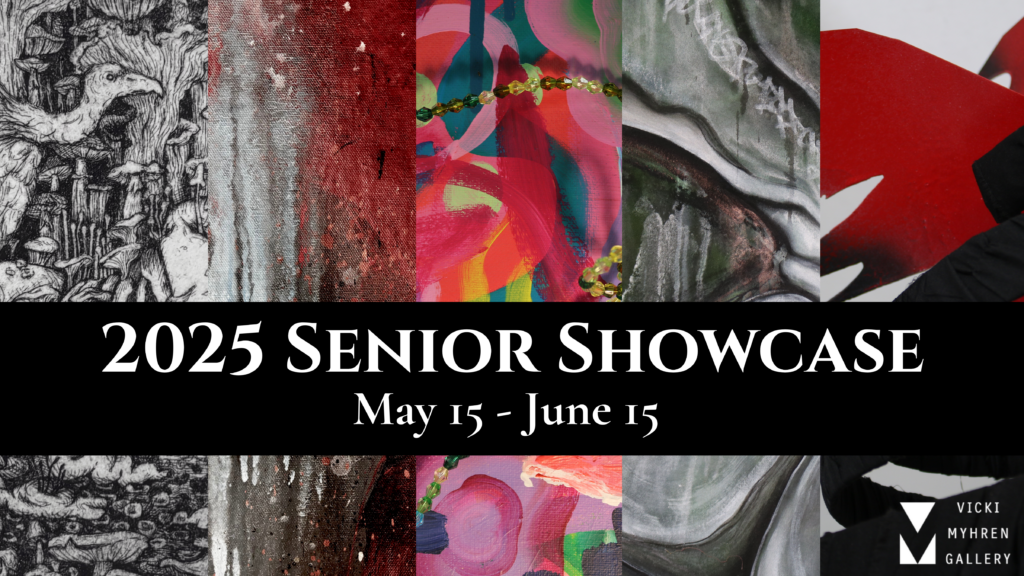
Join us on May 15 from 5:00-7:00 PM to celebrate the artists
Bachelor of Fine Arts Exhibition Gallery Guide
On View in the Vicki Myhren Gallery and Shwayder Lobby
Bachelor of Arts Exhibition Gallery Guide
On View in the Davis Gallery
Embodied, Unspoken
2025 Bachelor of Fine Arts Exhibition
Through distinct styles, these artists explore the connections between growth, decay, identity, expression, and memory. Many of the works process personal experiences through artistic exploration and question preconceived notions of the beautiful, the natural, and the self.
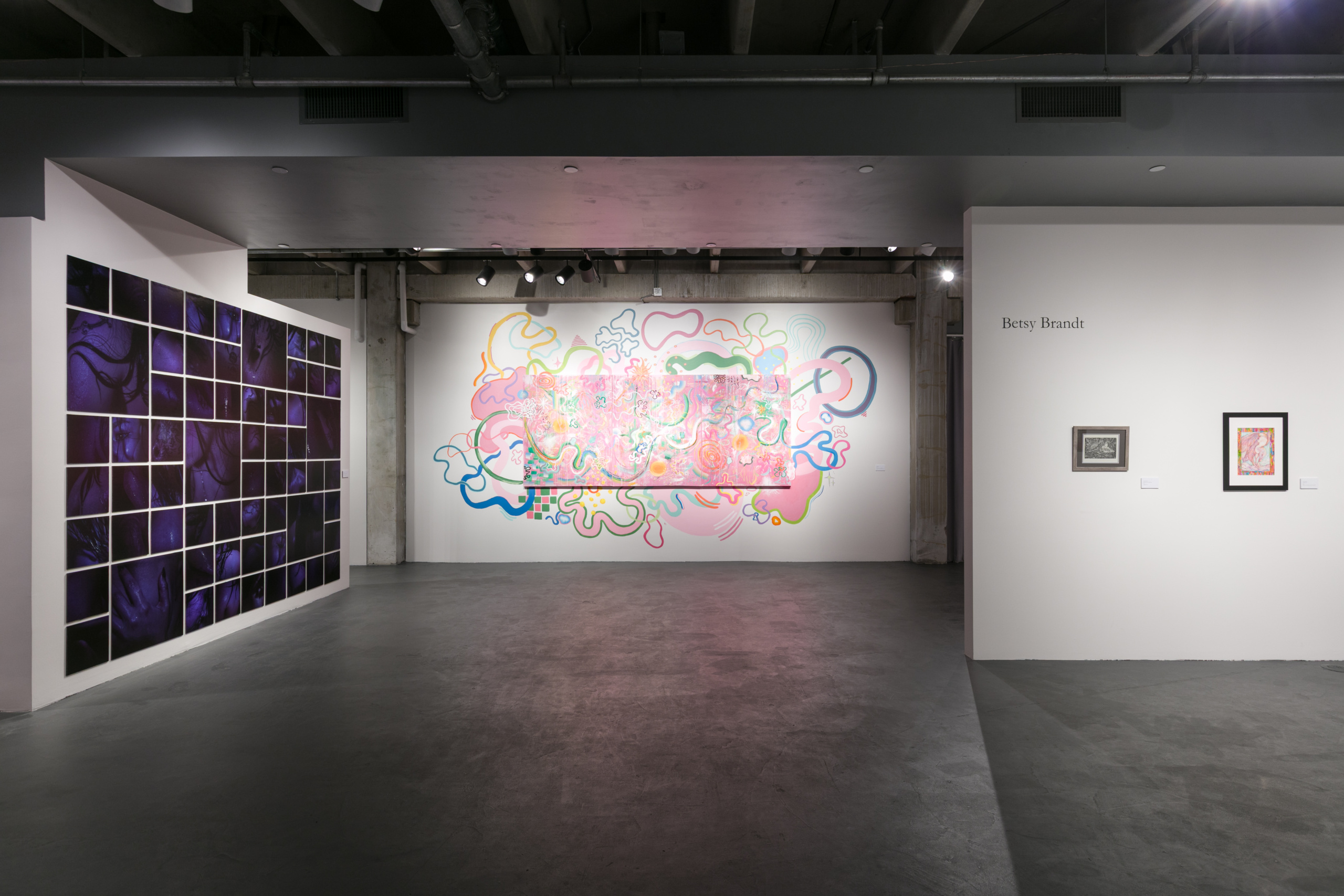
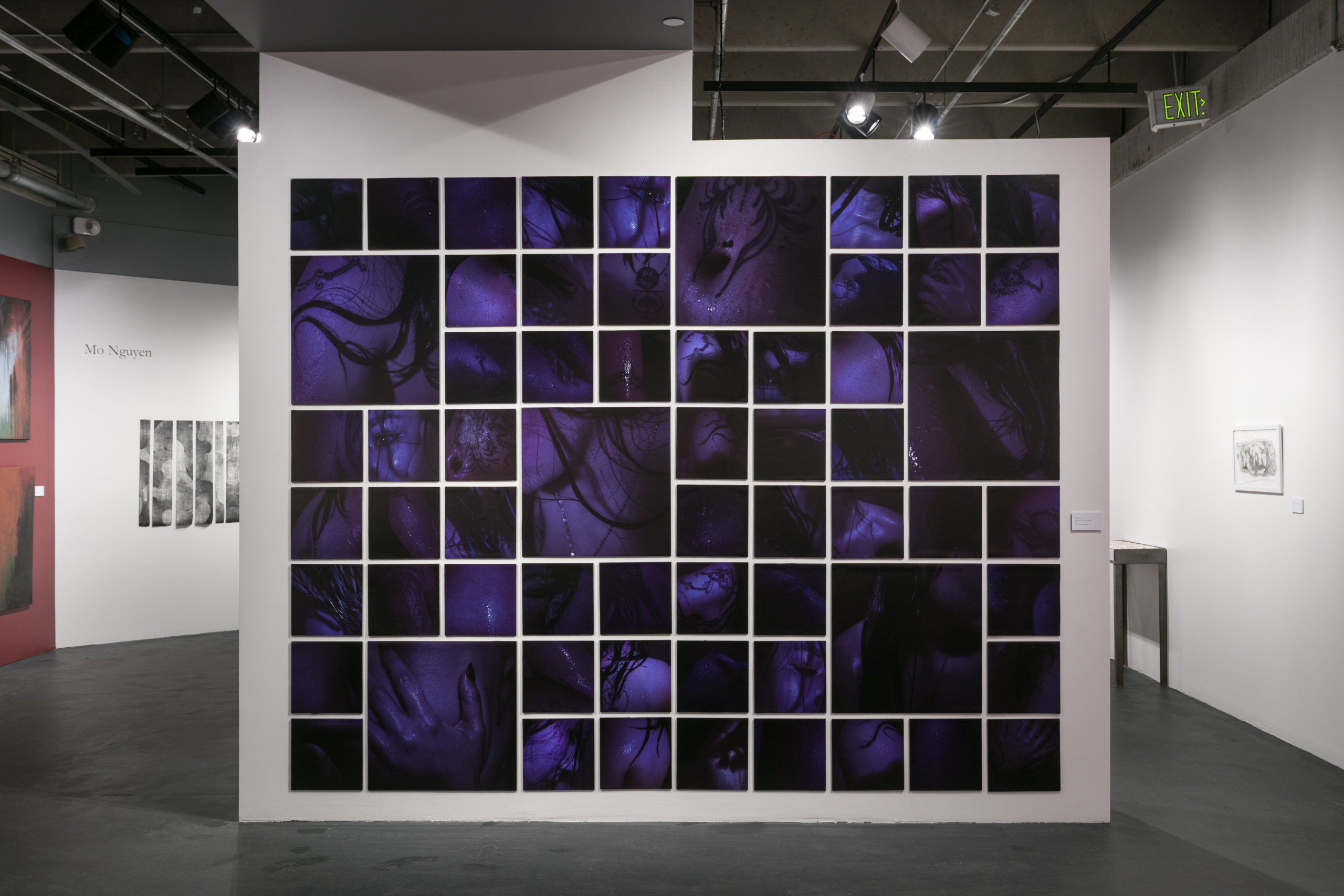
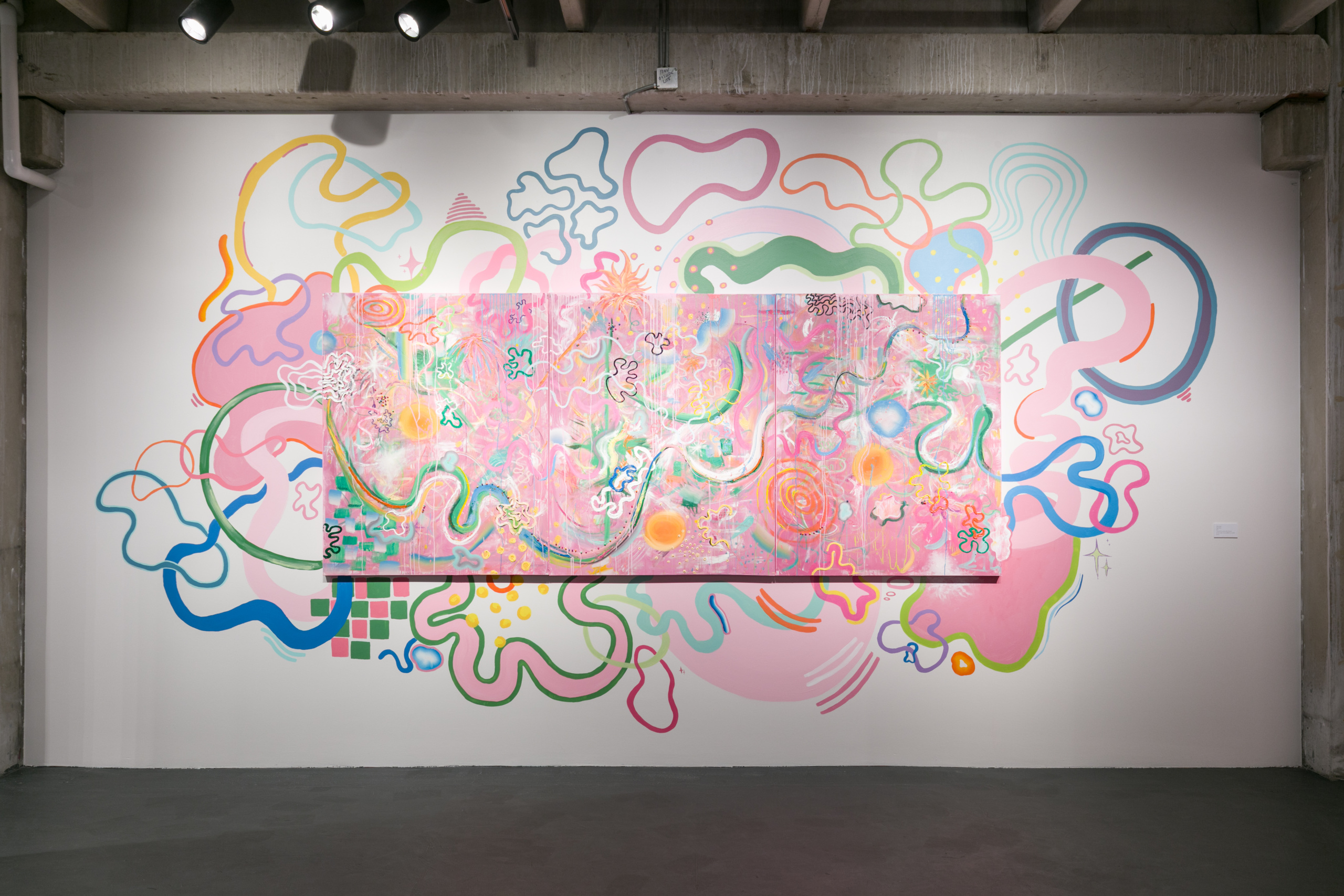
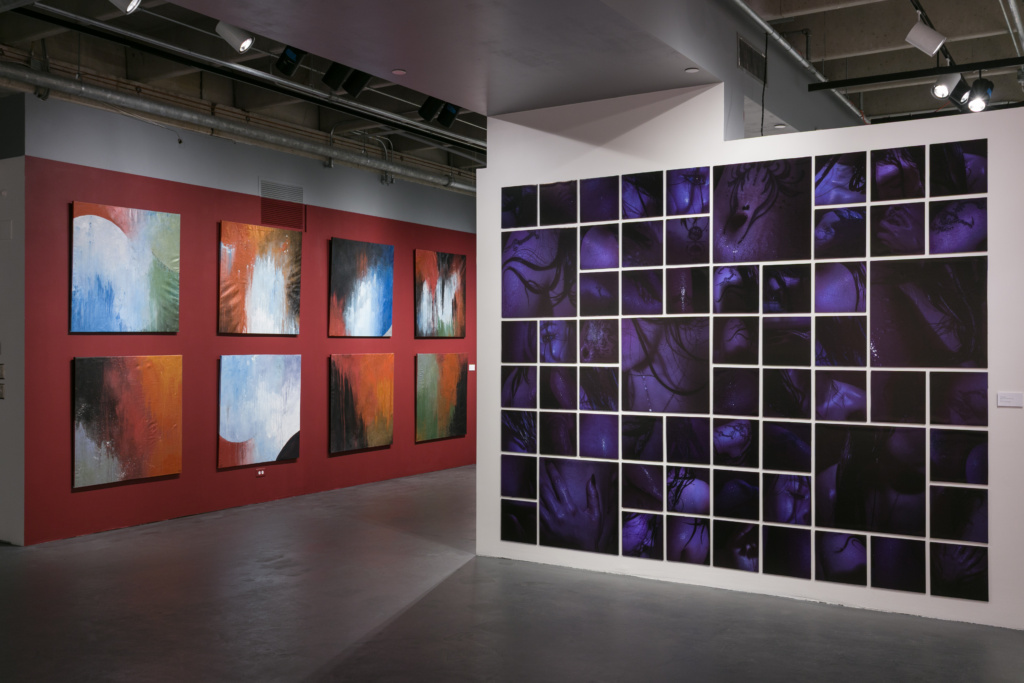
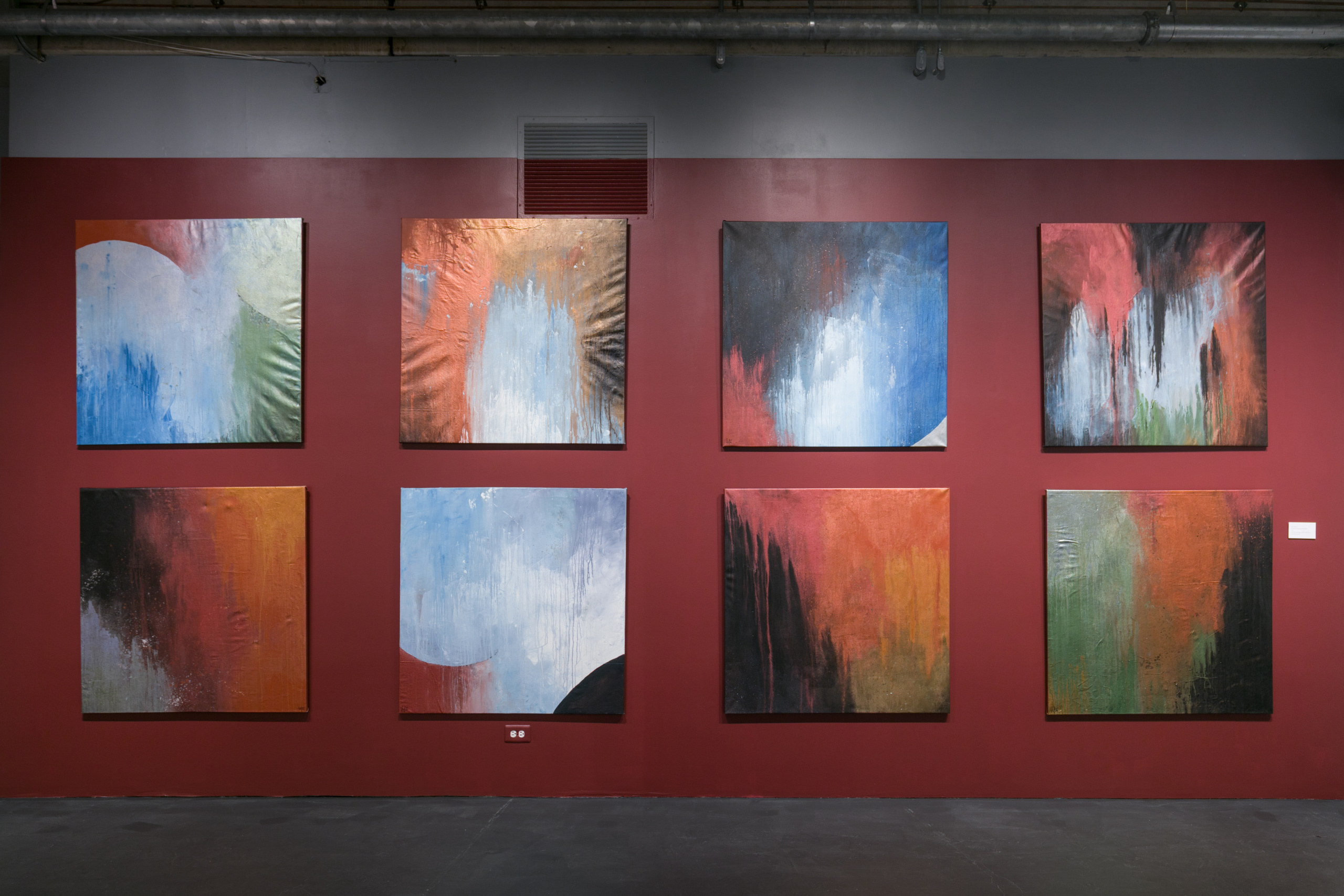
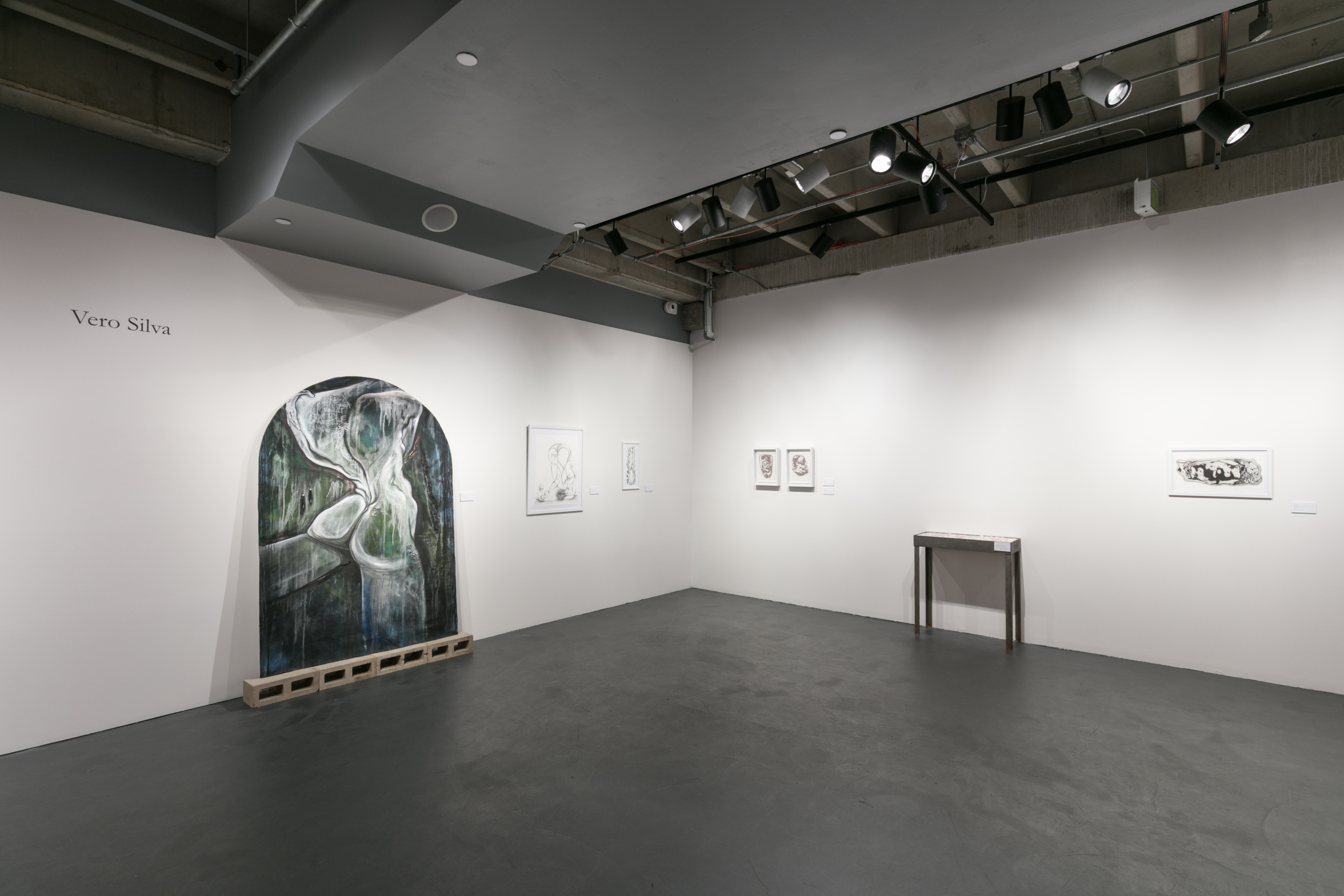
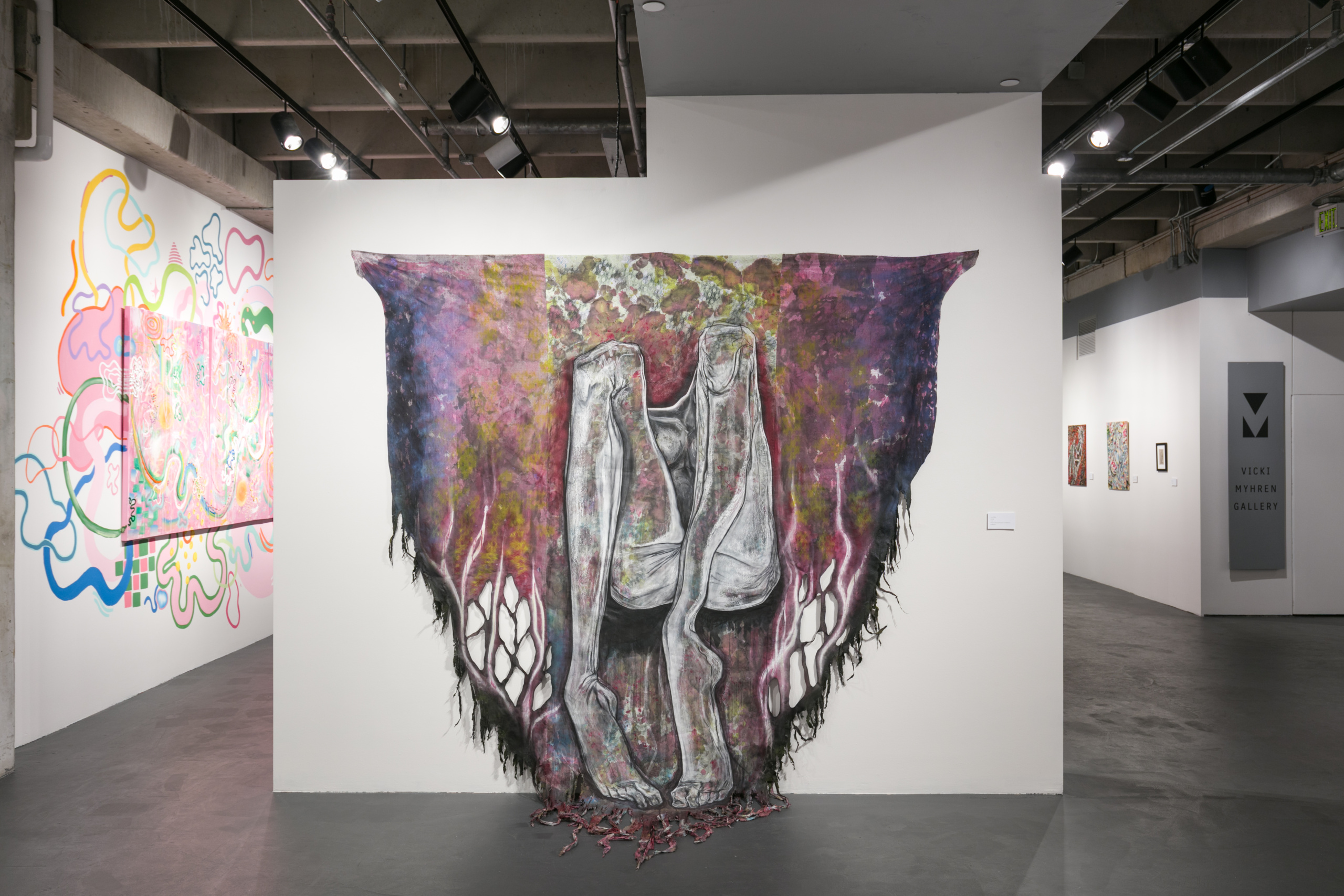
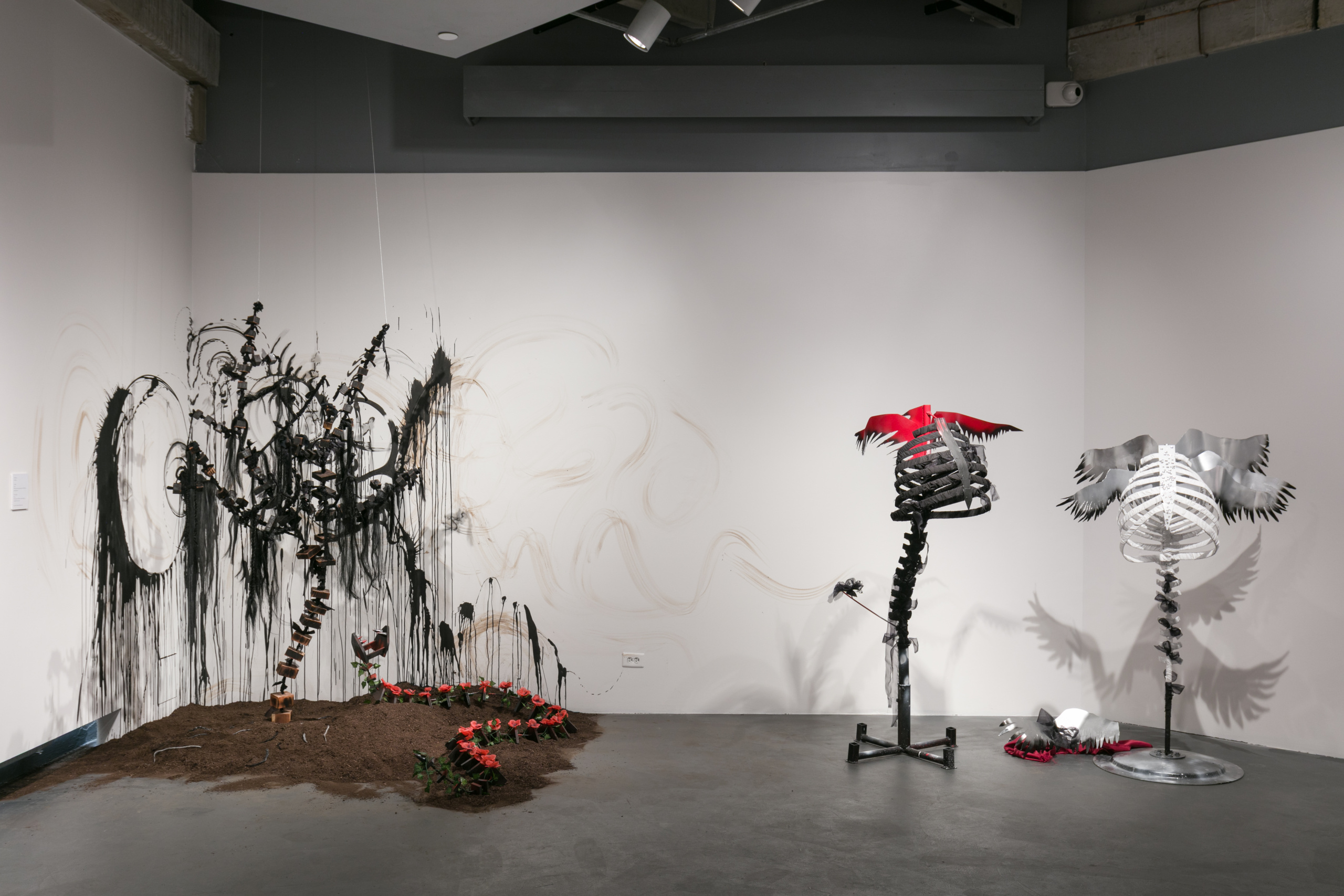
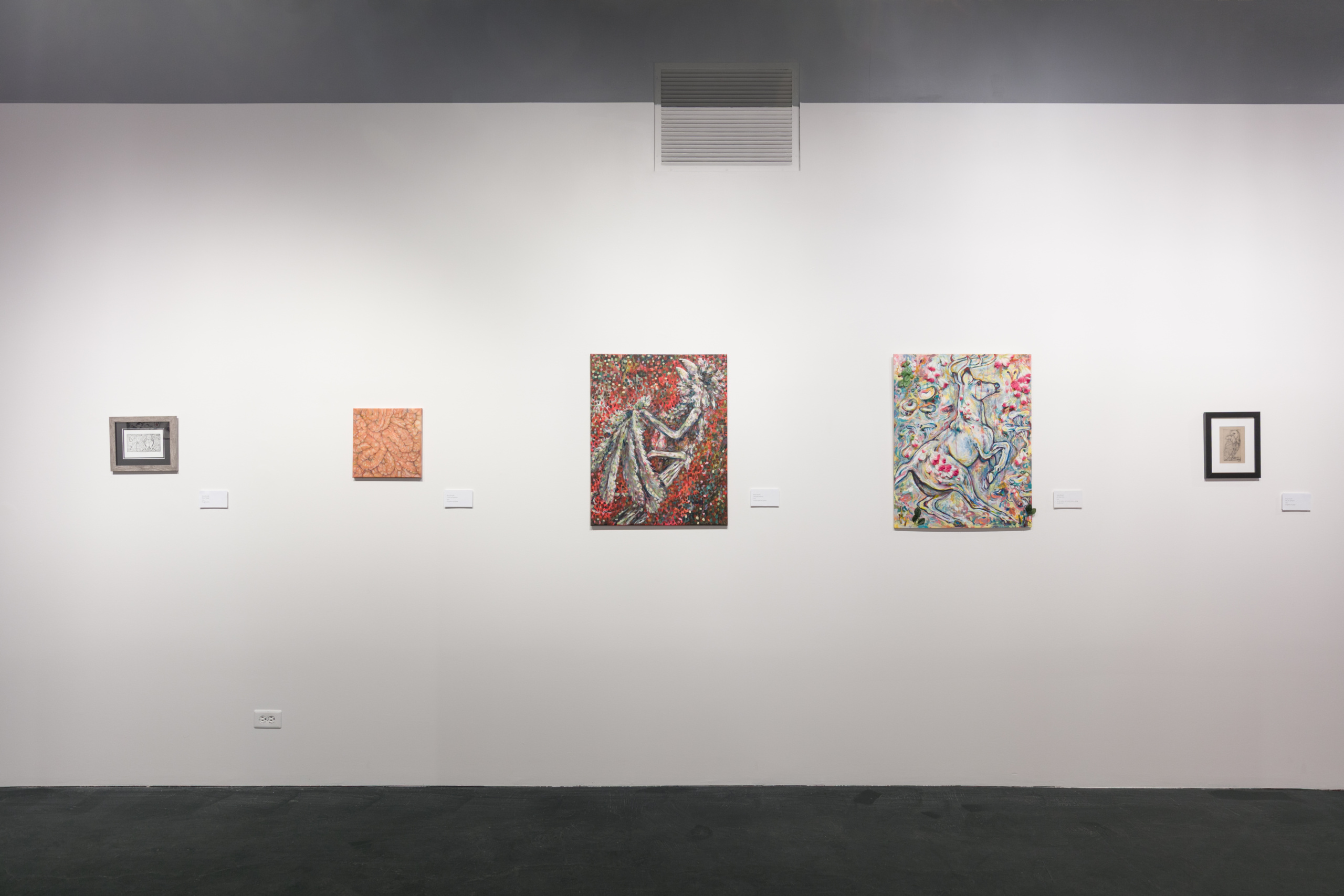
Photos by Wes Magyar
MJ Allen
j4dedbl4de.wixsite.com/studio | @j4dedbl4de
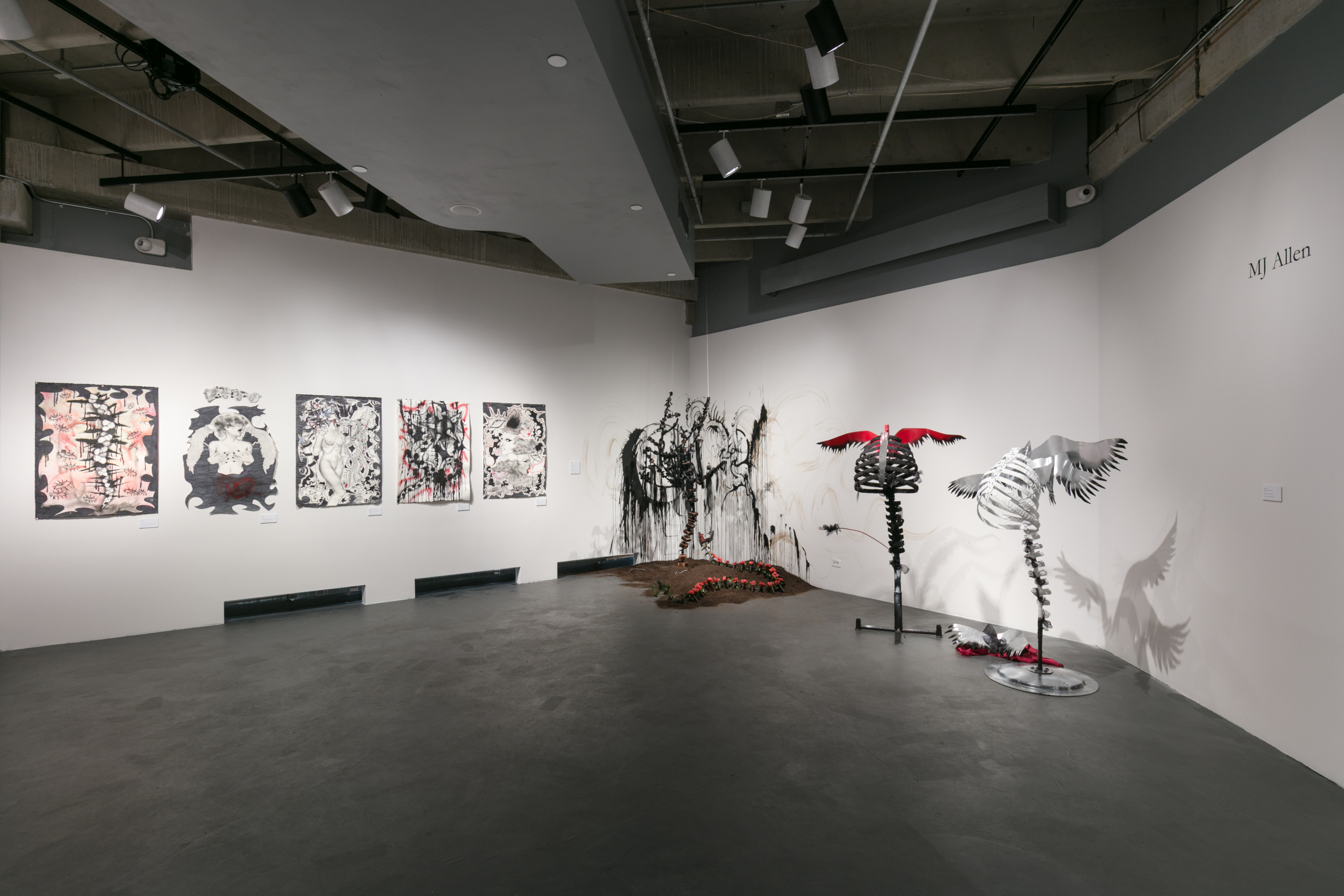
Divinity Within utilizes artistic practice to reclaim and celebrate personal identity. Using drawing, wood, and metal work, I explore my empowerment from organized religion, mental health challenges, race, gender, and sexuality suppression. I use my artistic practice to reclaim my spirituality by utilizing both religious and mythical imagery to craft my own truth.
When our piece of the world holds expectations for what you’re “supposed” to be, self-discovery can be quite tumultuous. Many of us have known what it feels like to have expectations put on us that feel inauthentic to who we are physically and metaphysically. We all owe it to ourselves to honor who we truly are and how we feel. Our bodies and our essences are palaces. Whether physically, mentally, emotionally, or spiritually, we deserve to feel empowered, fulfilled, and authentic. We are our own vessels for walking amongst the familiar and unfamiliar, for containing hard drives of experiences both past and present. Our love, our light, our pain, our dark— we all have unique paths, stories, and emotions. “Infinite Mortality V, I & II” highlight this through their juxtaposition, whilst demonstrating the divinity of it all within the form. From stages of loss to joyous celebrations, from shambles to growth and healing, the one common factor across the board is YOU. “The Watcher and The Watched” explores this concept by examining how pain, persistence, and growth allow us to find the divine within ourselves. And because of how significant our sense of consciousness is to us, we adorn ourselves in our favorite drapes, we tame the locks on our scalp to our liking, we embroider our arms and legs with inks that speak without a single word being spoken, we pierce our skin with metallic accessories…. The list goes on.
Pieces like “Fortitude” demonstrate finding personal pride in this adornment, as the braid is a personal symbol of cultural pride, expression, and resilience in navigating the world as my authentic self. The fact of the matter is this: Our bodies truly are temples, the divine exists in all of our hearts, and we all have our truth to embrace.
Being raised Christian, I often faced challenges not just in discovering, but in embracing my self-expression due to religious expectations. Although internal and external hardship often followed, it has been rewarding to persist in finding my own eye of the storm through the chaos. As I reflected upon such, I was inspired to create a series of self-portraits, some more direct than others, that explored various dimensions of personal evolution to finding my light. My work is an effort to emphasize that, regardless of one’s religious identity or spirituality, there is beauty in loving and embracing yourself in both the physical and metaphysical, and power in defying judgment and expectations to become the most authentic version of yourself. Unpacking queerness, race, gender, mental health, and authenticity, my work is not only an autobiography, but is meant to serve as a reminder to the viewer of the importance of cherishing your autonomy and self-discovery, as it will bring meaning to your life. “The Tree of Life” and “Lucifer” are meant to highlight this through utilizing remixed Christian imagery to express the theme that finding your light, your life, can often mean finding beauty in the darkness, too. It is essential to explore in the name of your autonomy. Finding truth in your existence is something we all deserve, regardless of who you are. Through my artmaking, ranging from intuitively crafted graphic drawings to larger, bold sculptures, I have been able to increasingly both find and embrace my truth, and I hope that my work serves as a reminder to my viewers to do the same.
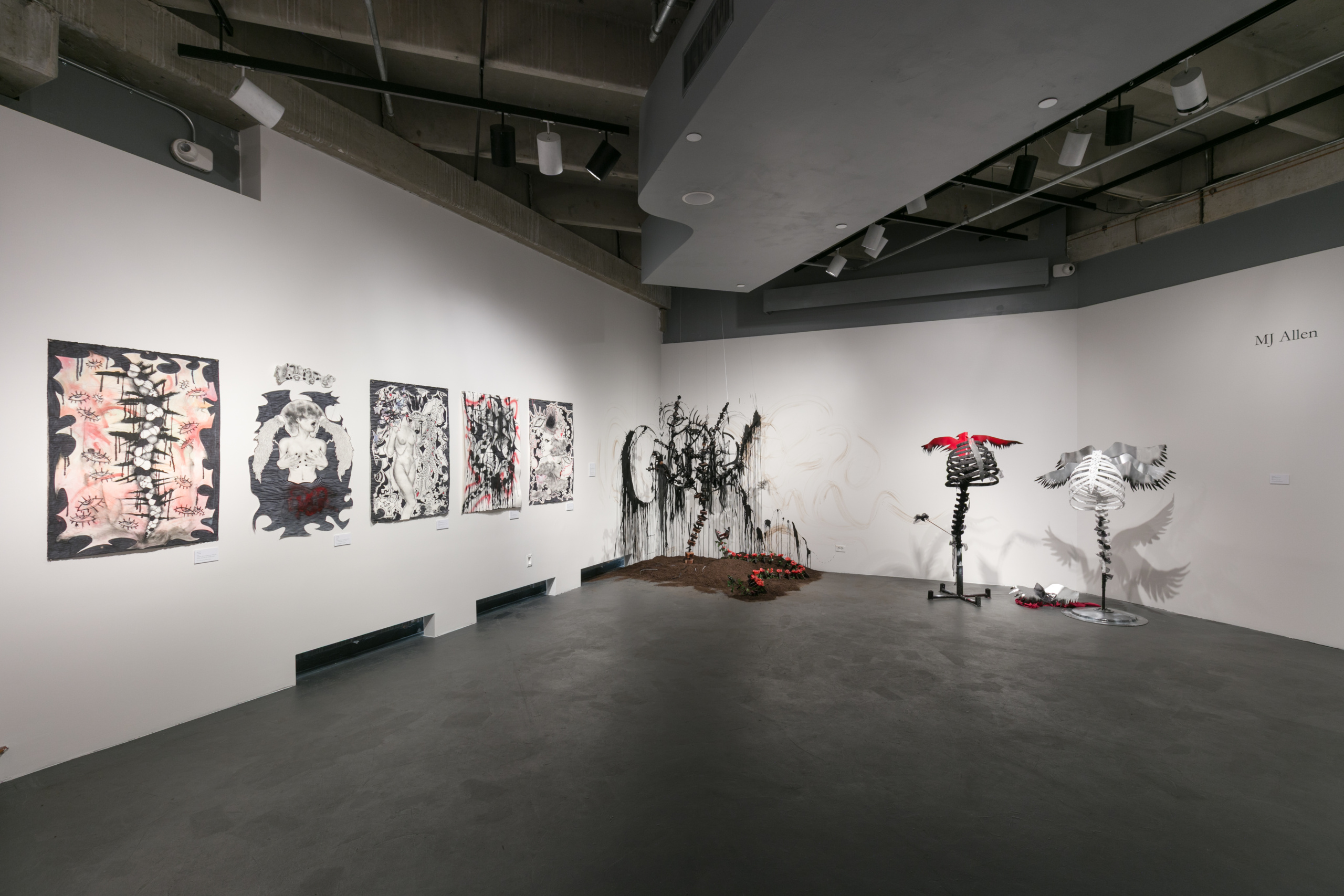
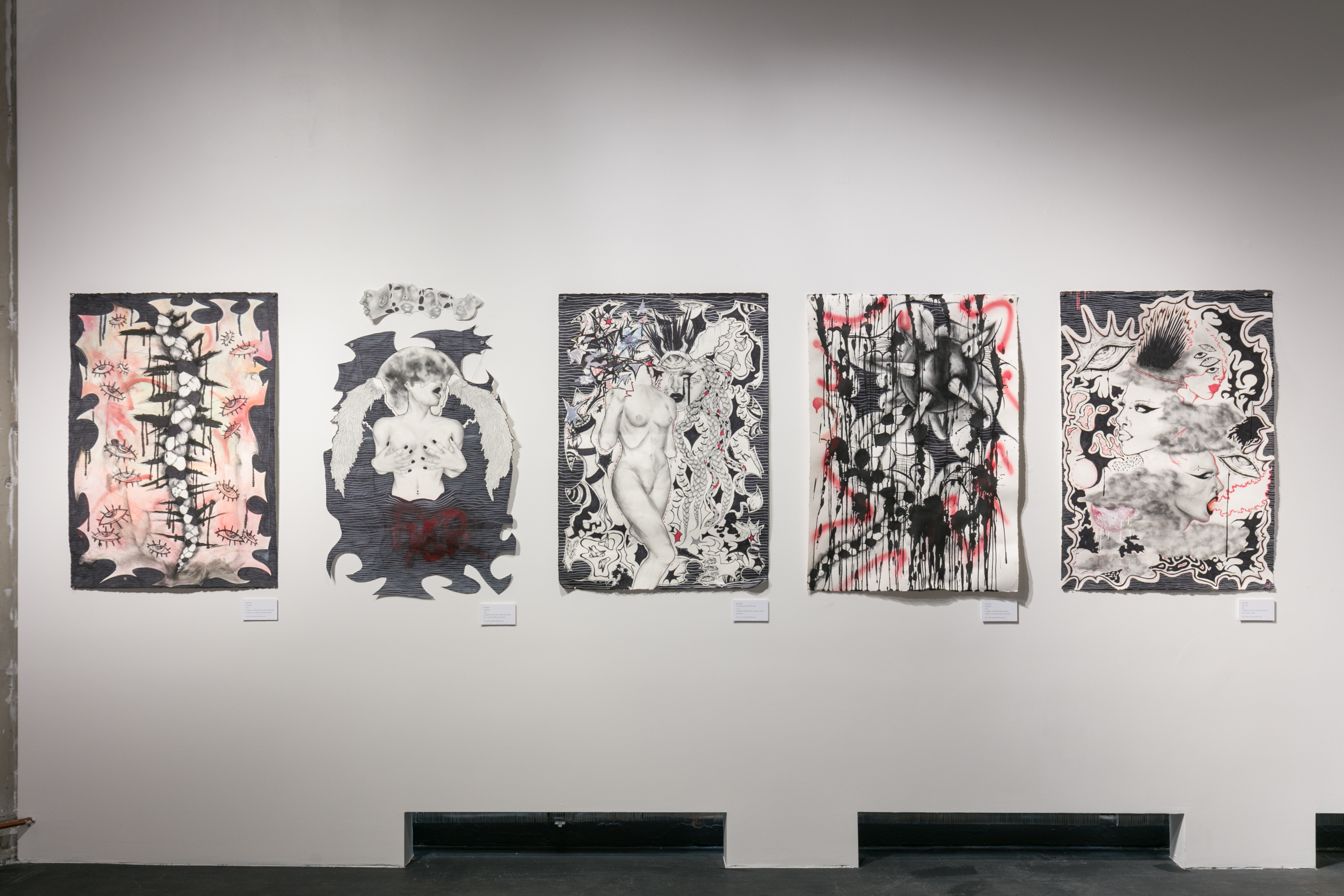

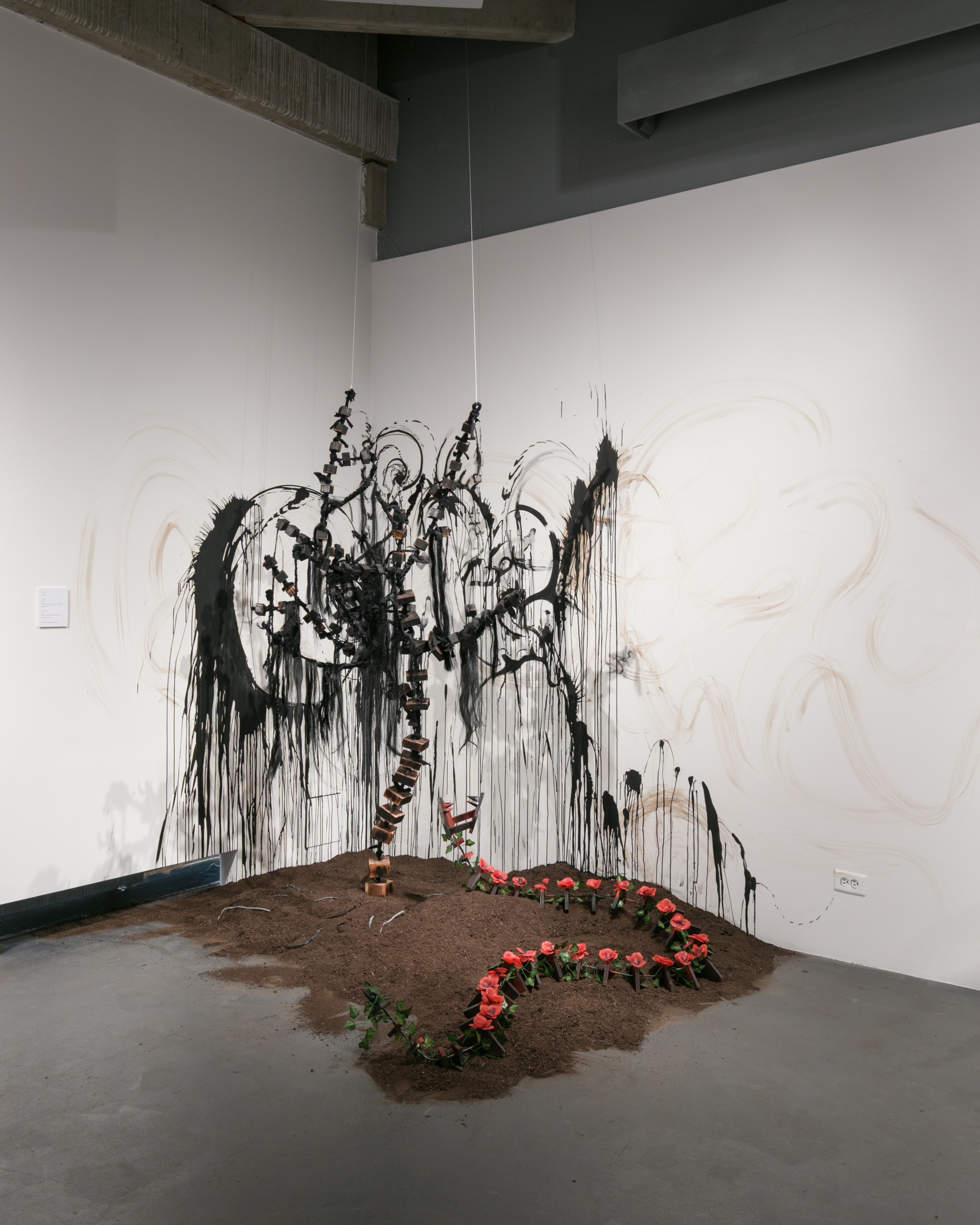
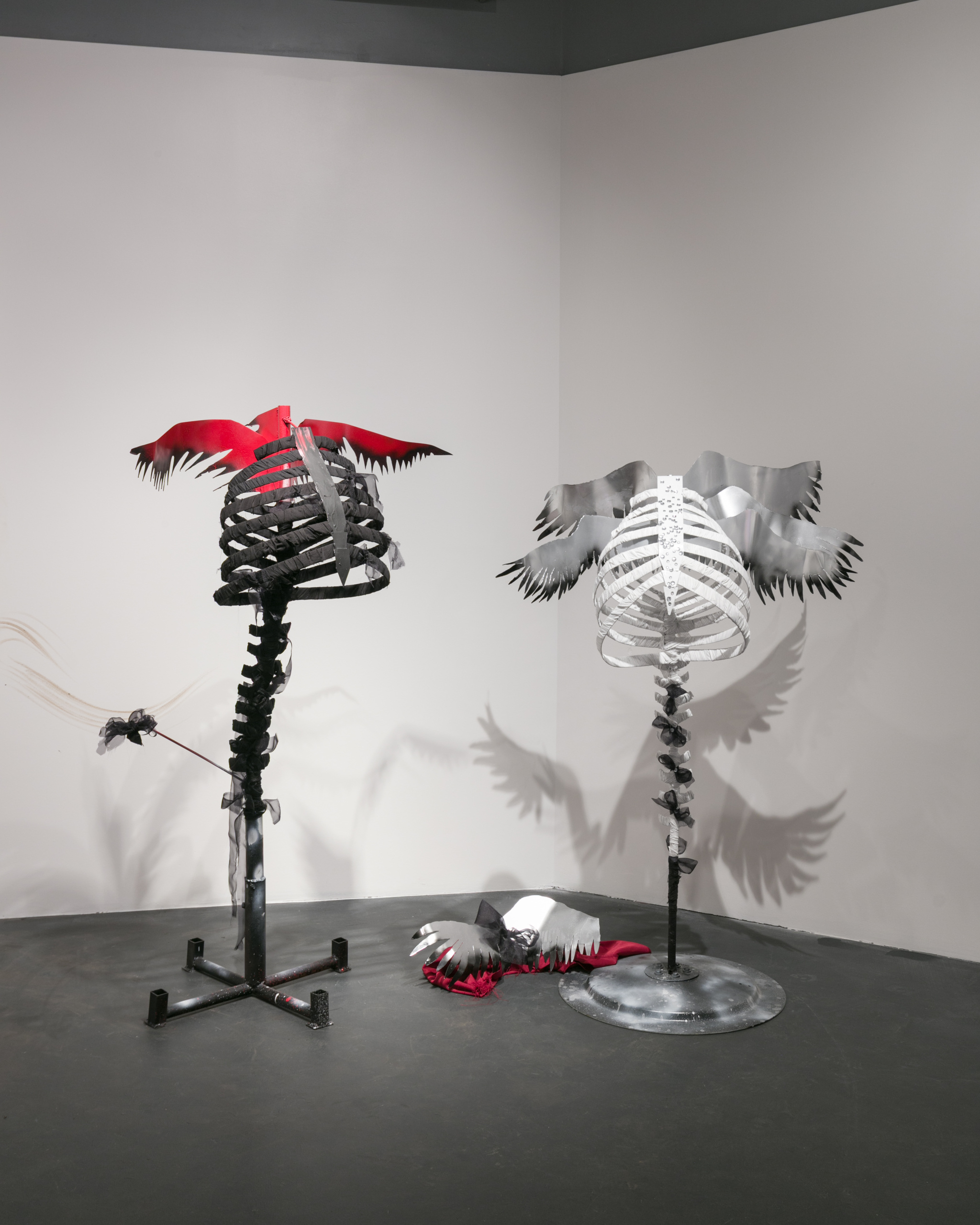
Chloe Blesi
https://chloeblesiportfolio.com | @cblesiart

Chloe Blesi’s work is grounded in care—for her subjects, her materials, and the emotional spaces they inhabit. Influenced by nature’s cycles and the complexity of womanhood, Blesi’s paintings evoke both internal and external landscapes. Through vibrant, layered compositions, she captures how beauty and vulnerability emerge in the spaces between us. Her paintings explore themes of femininity, self-love, and human connection, creating environments that feel simultaneously fragile and strong, intimate and vast.
Using oil, acrylic, and mixed media such as beading, wire, and digital animation, Blesi builds fantastical, abstracted botanical ecosystems that unfold across her surfaces. Thick layers of paint form organic shapes and gestural marks, creating a visual rhythm where movement, tension, and growth push against and flow with one another. Her evolving surfaces bridge two- and three-dimensional space, inviting viewers into immersive worlds alive with texture, motion, and emotional resonance.
Her use of florals—lilies, orchids, and hibiscus—recur not as decoration, but as symbols of time, memory, and transformation. Petals droop, lines swirl, and vibrant color palettes buzz with energy, capturing both the joy and discomfort of existing in a female body. Her work reveals an ongoing negotiation between fragility and resilience, holding space for contradiction, transition, and care.
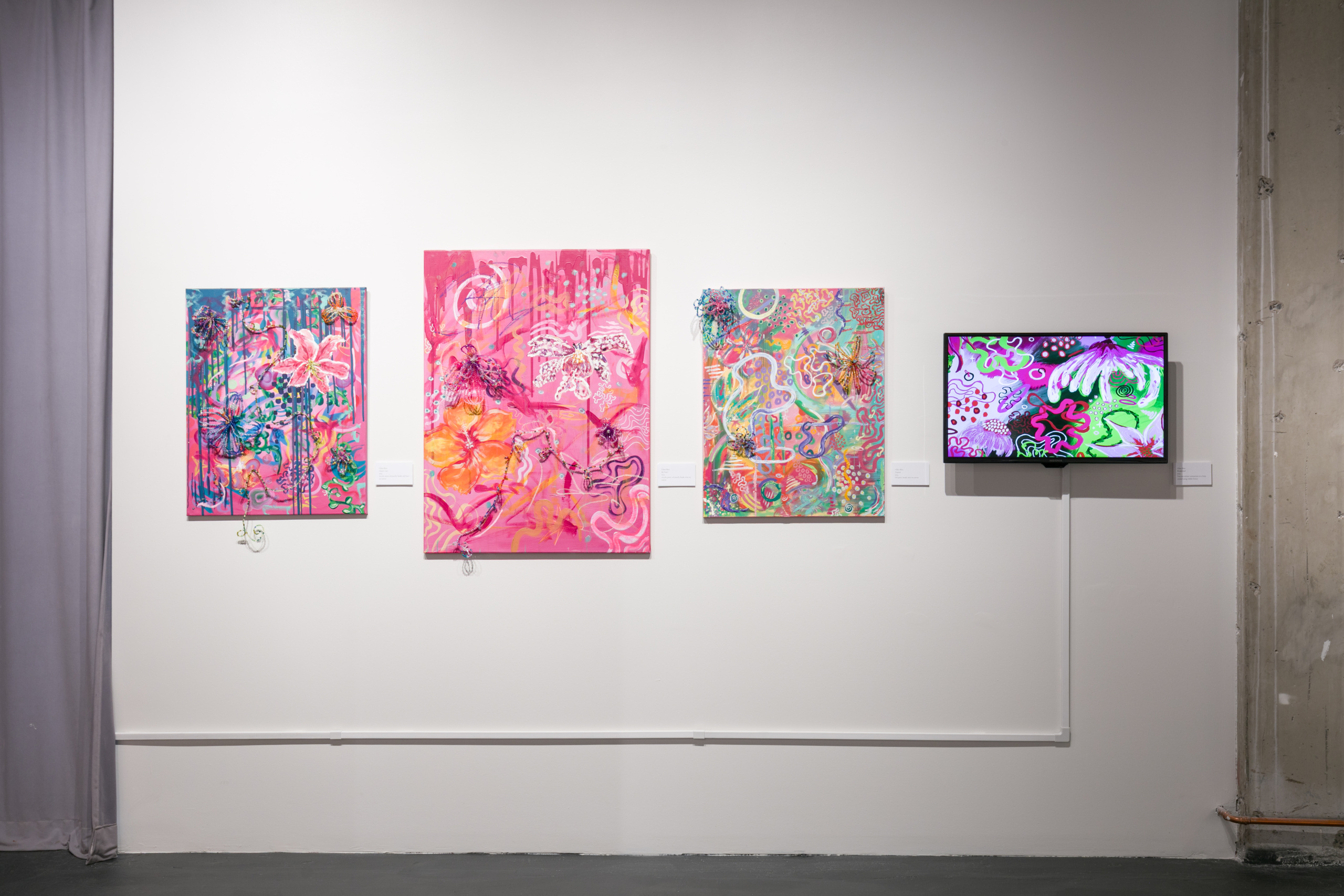
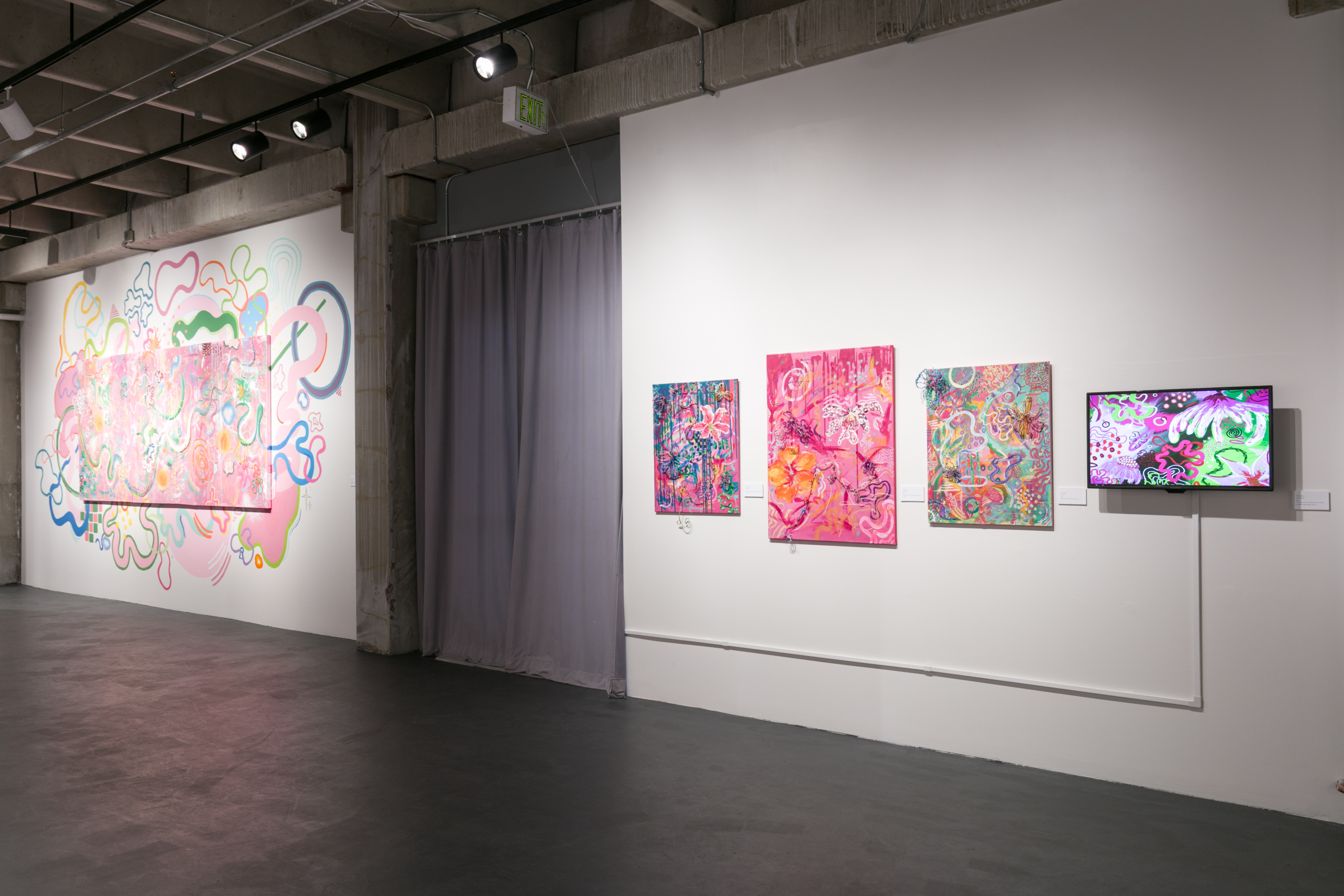
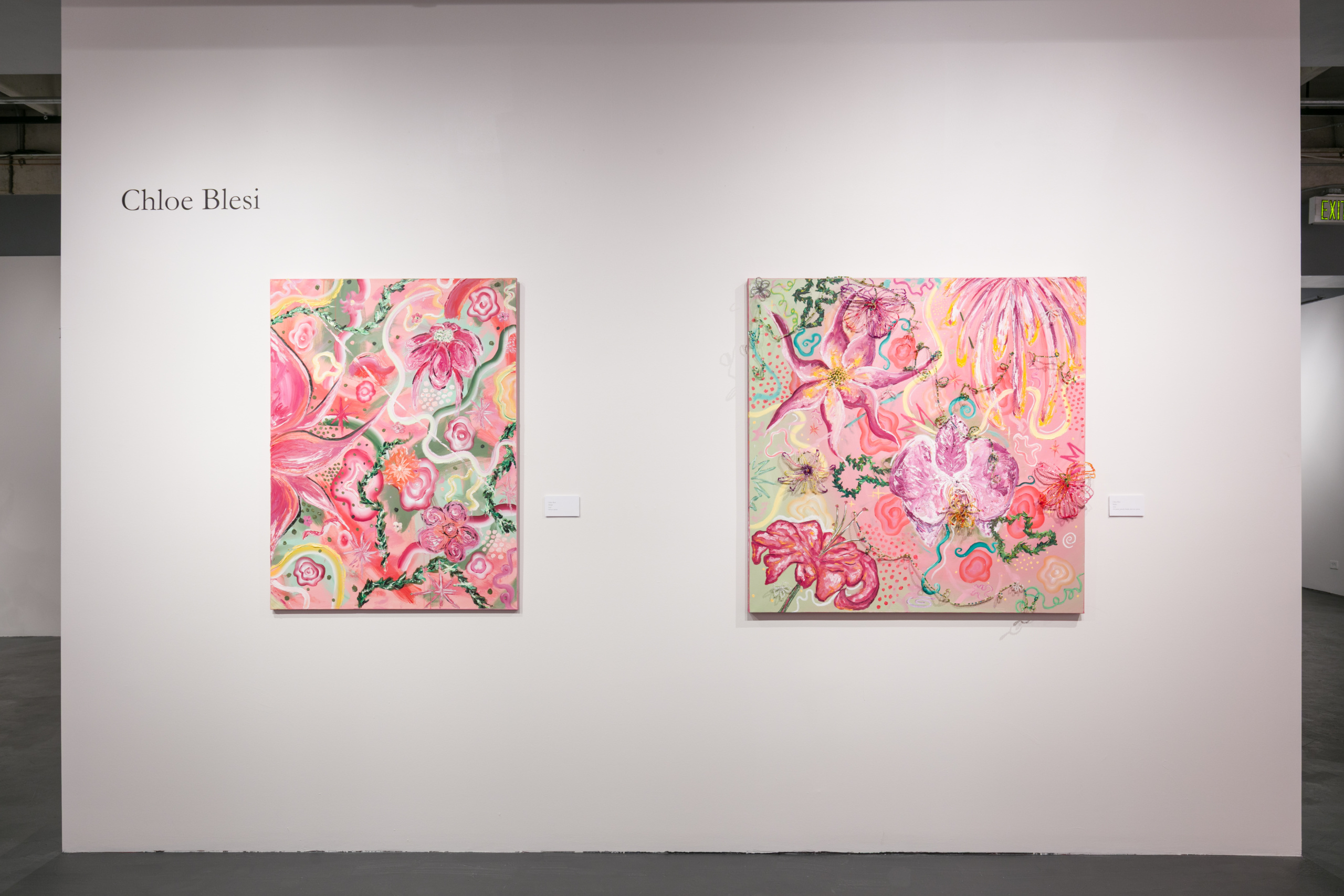
Betsy Brandt
@bbrandtstudio
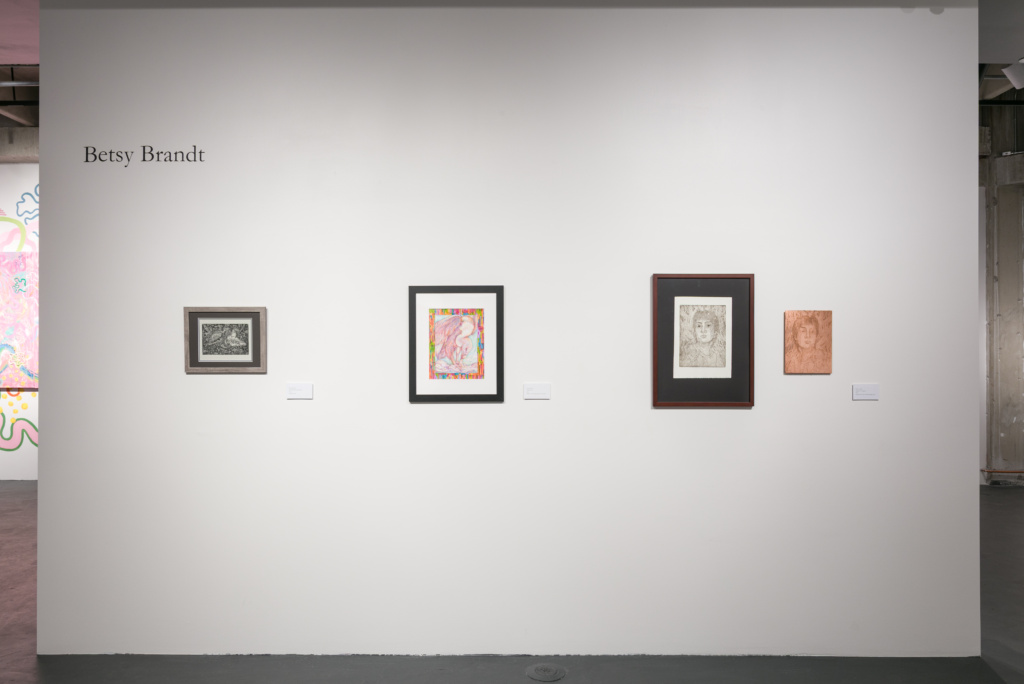
This year, I have been creating work inspired by natural forms and ecological processes. I am specifically fascinated by organic cycles generally met with revulsion including scavenging, predation, and decomposition. I find solace in the existence of organisms that survive off decay, as they give death meaning. Vultures, fungi, and carrion are consistent subjects in my practice. Vultures’ bodies are specialized for scavenging, and they protect their habitats by consuming disease-ridden carrion. Their incredible role contradicts media depictions of vultures as harbingers of death. I create works featuring these magnificent creatures to impart the reverence I hold for them and hopefully change their threatening reputation.
The fruiting bodies of mycelium that grow from decay are similarly looked at with disgust. The cycle of decomposition is comparable to reincarnation. Mushrooms blossom from the expiration of life, serving as nourishment for other organisms, who eventually die and become fungi fodder themselves. My work examines the beauty in this invaluable cycle of death, rot, and rebirth. With self-portraiture, I place myself within the context of this cycle. Illustrating these scenes helps me to conceptualize the daunting and inevitable fate that awaits all living things.
Formally, I reference naturally occurring patterns to add movement to my work, like those of roots, organs, and mushrooms. Because I work intricately, creating compositions that are packed and substantially detailed, my work prompts viewers to engage with my art intimately. By meticulously decorating my work, I depict the grotesque in a way that is visually appealing, enchanting viewers with the same subjects that would repulse them in all other contexts. While the formal elements of my work are important to me, I also find the artistic process greatly fulfilling. The repetitive motions of etching, painting, and sculpting satisfy me, and I am able to enter a hyper-focused state where I feel truly content. Conceptually, art making brings meaning to my life by allowing me to explore my scientific interests and cope with my fears.
As my undergraduate career comes to a close, I wish to extend gratitude to everyone who has helped me along the way. I am eternally grateful for the opportunities I have been given to study art and pursue my greatest passion. Thank you to all who have supported me and my work. I would not have made it this far without you.
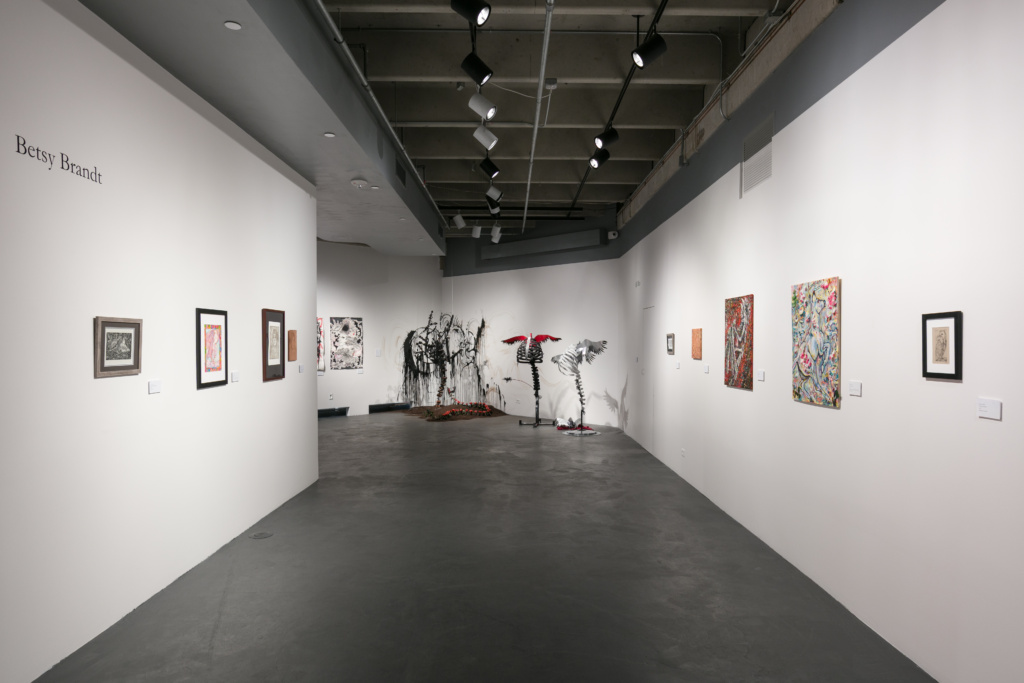


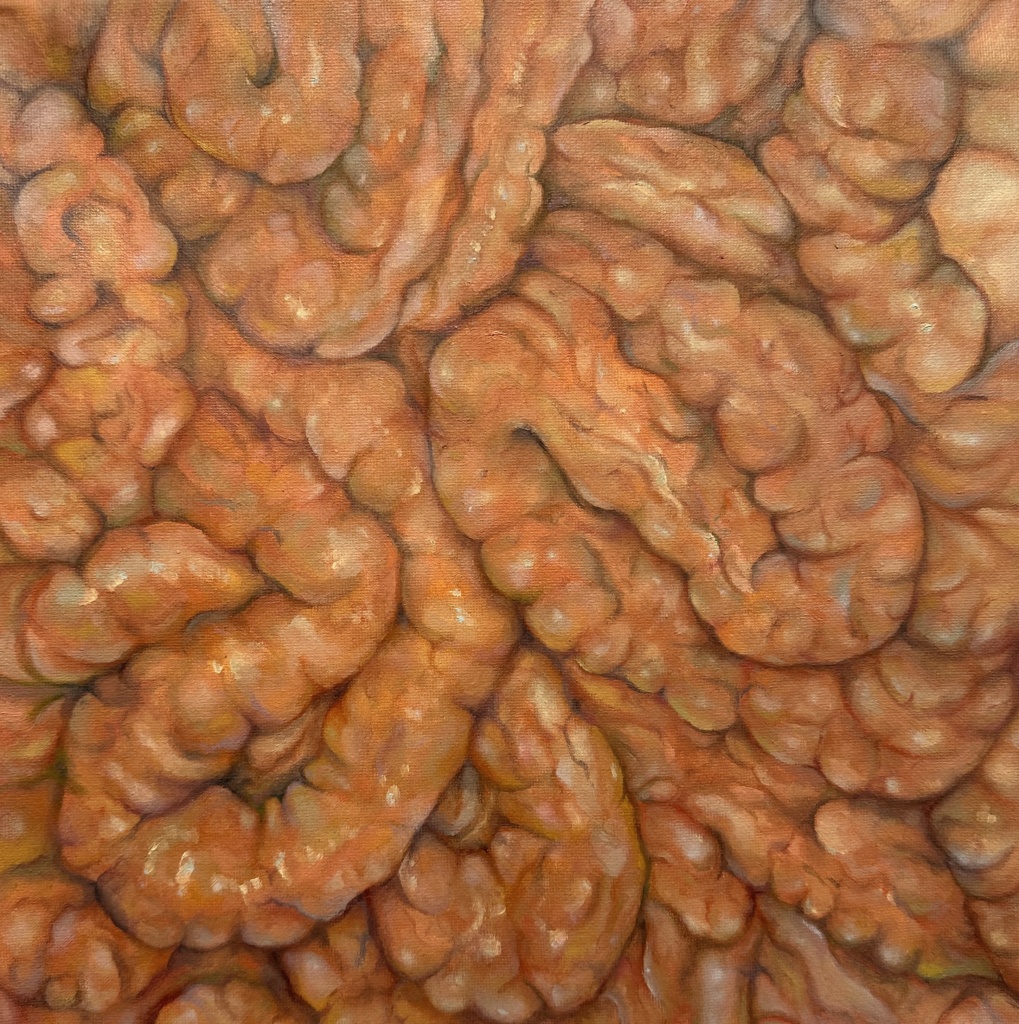
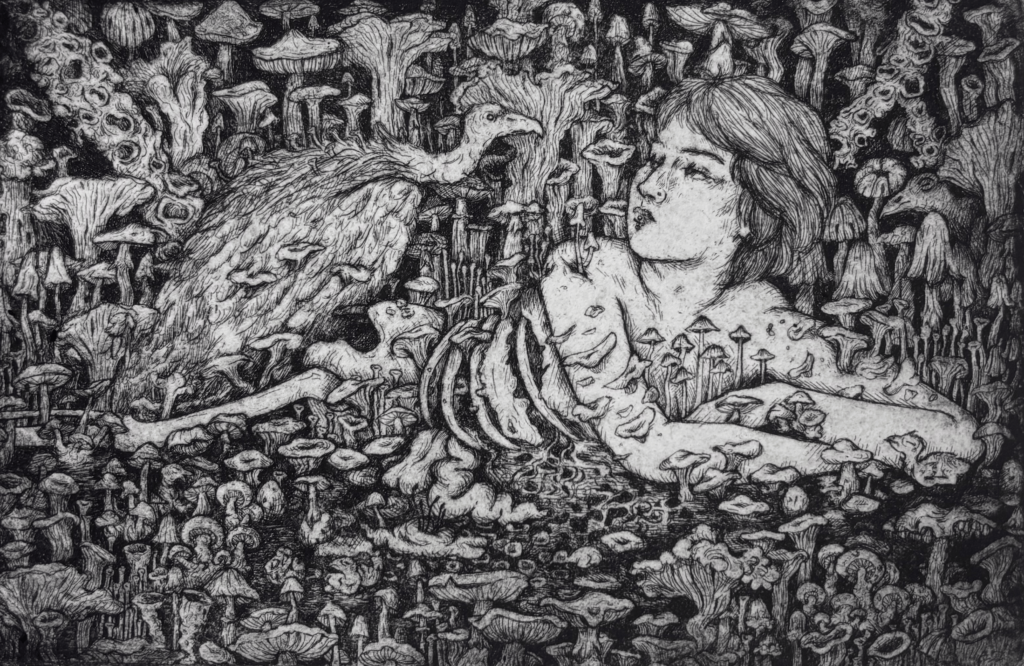
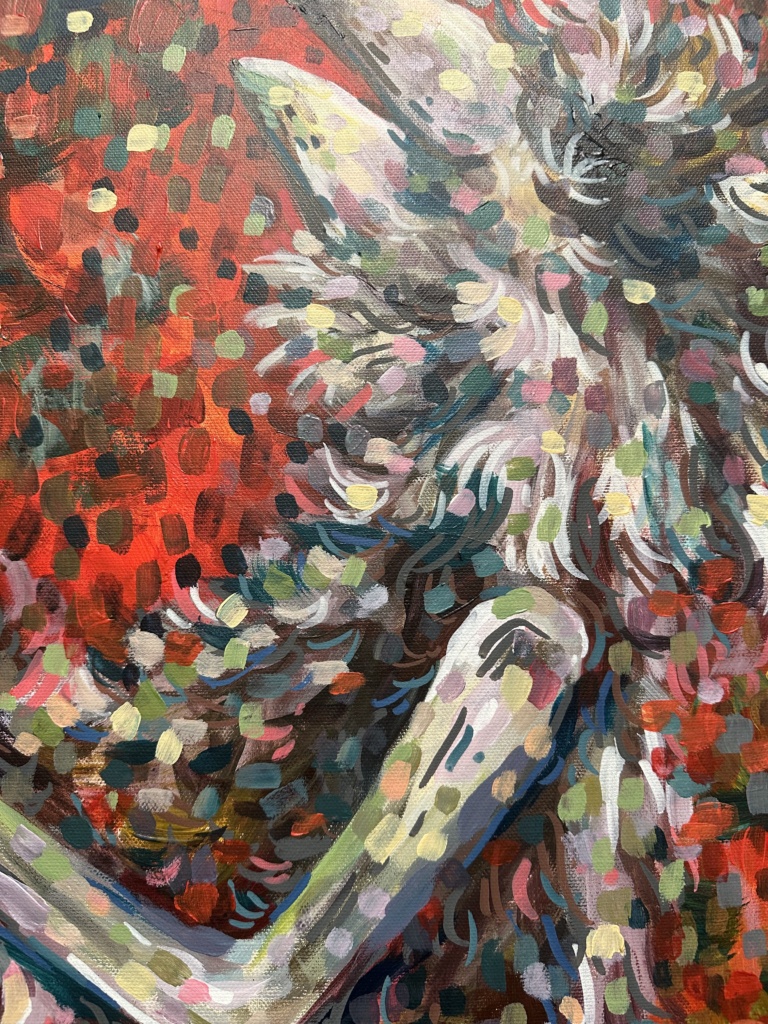
Mo Nguyen
https://mosportfolio.wixsite.com/monguyen | @ehh_its_art

Mo Nguyen is an artist based in Denver, Colorado. Working across in painting, printmaking, and photography, Nguyen’s practice is grounded in personal experience, using art to process and reflect on complex experiences and emotions. She has participated in workshops at the Anderson Ranch Arts Center and continues to seek opportunities that foster experimentation, community, and growth. Nguyen primarily works in oil painting and intaglio printmaking, exploring themes of memory, vulnerability, and the body. Her work often blends figuration and abstraction, utilizing symbolic imagery to create space for contradiction and emotional depth.
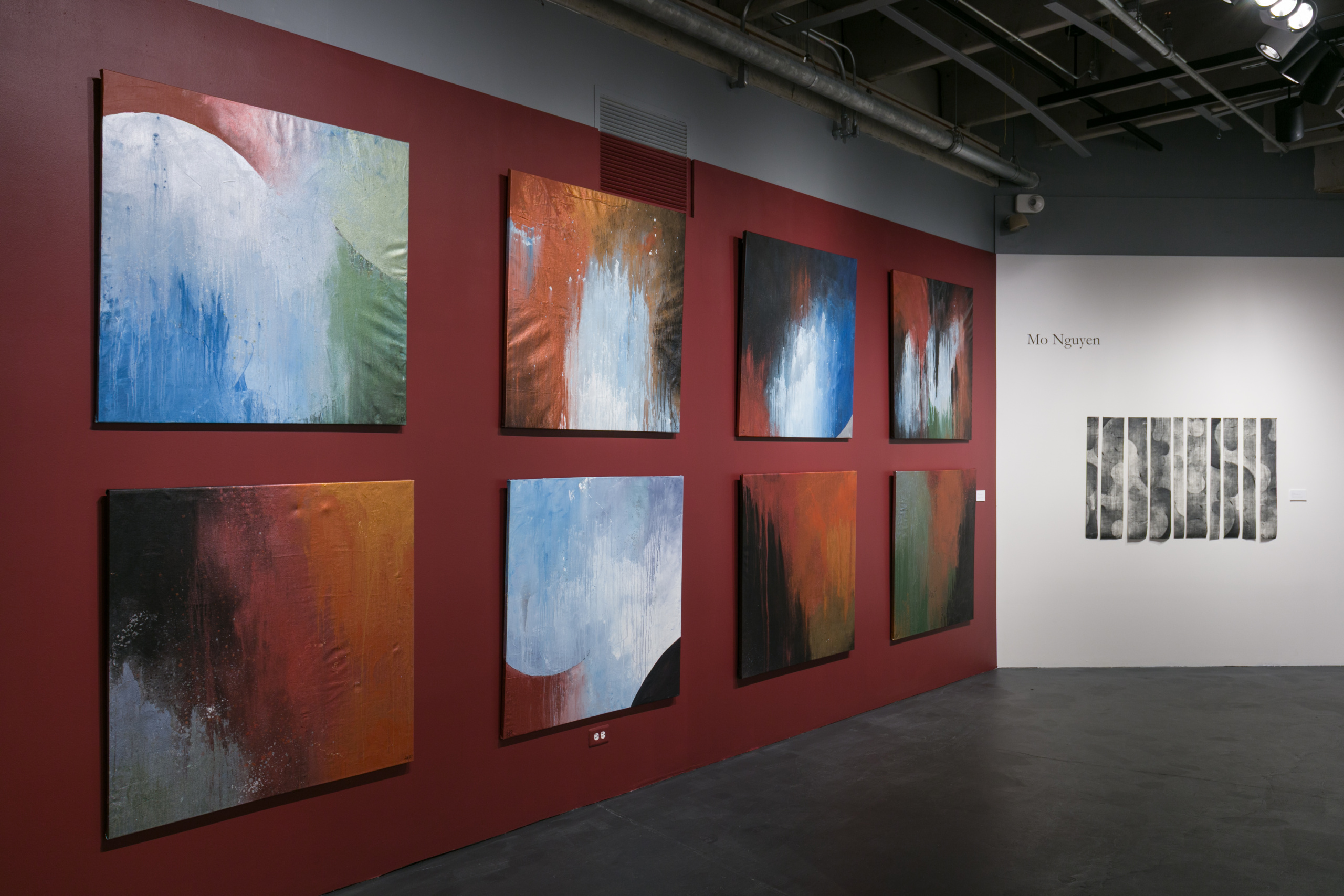

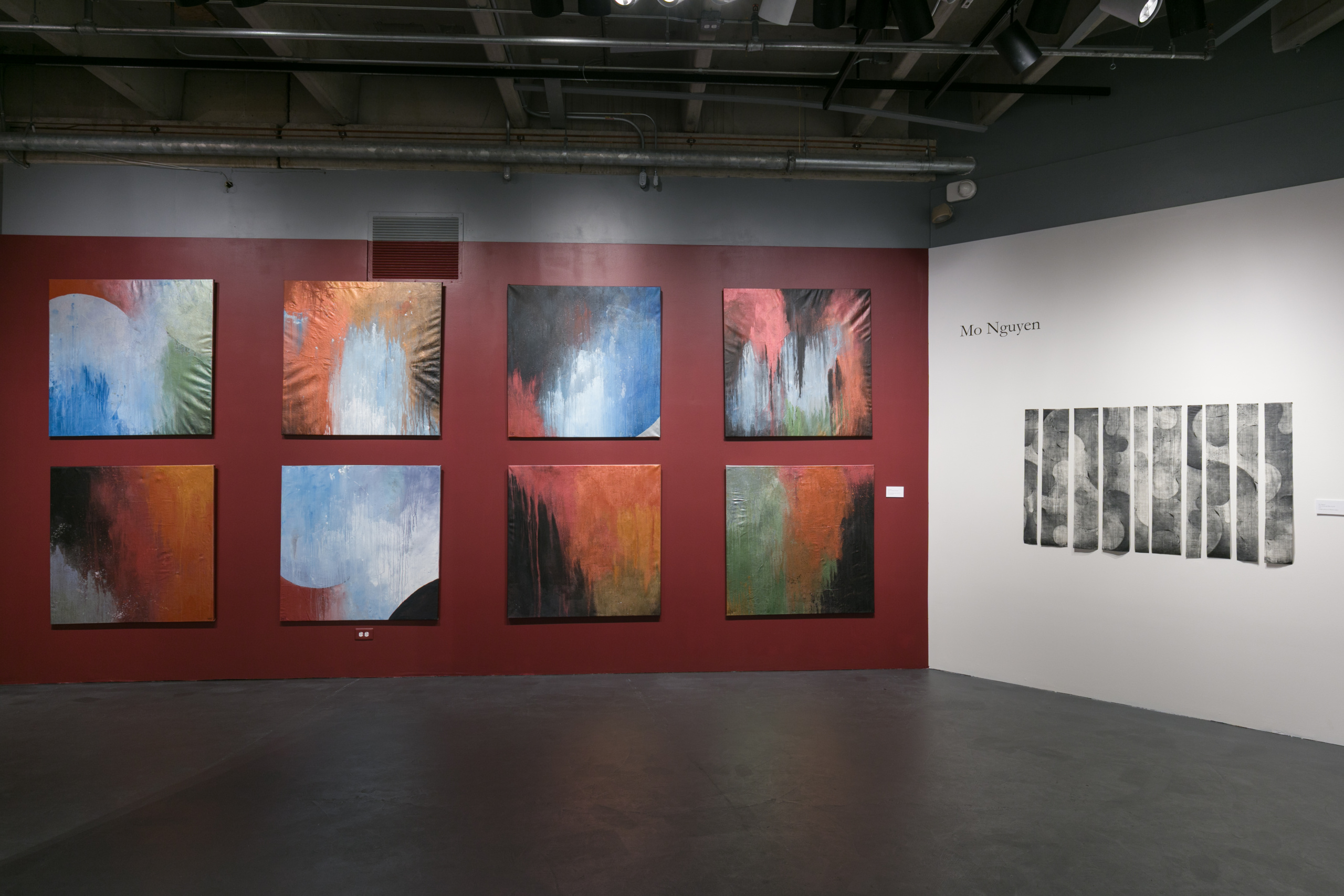
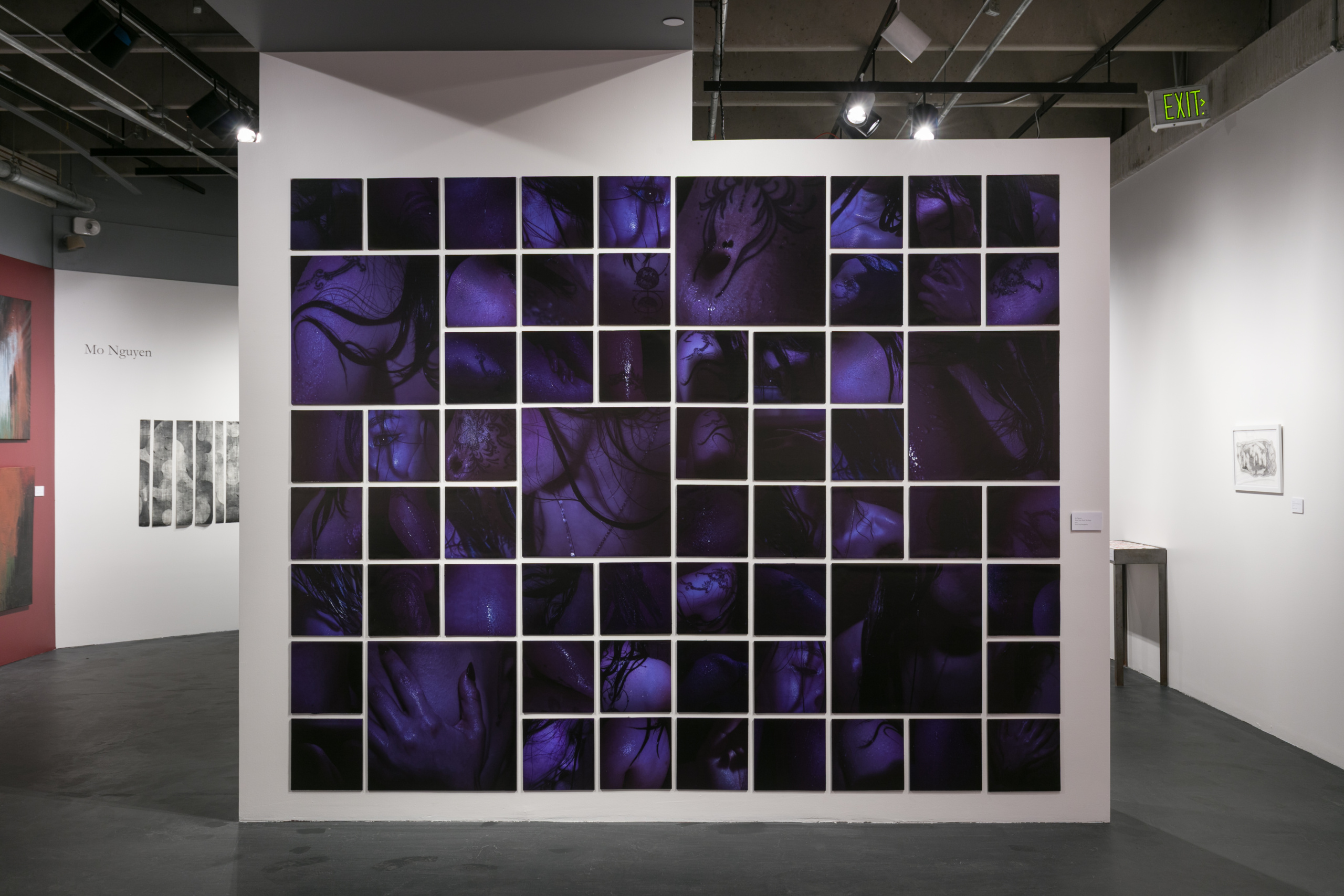
During my senior year at DU, I made a promise to myself to have more fun – academically, socially, personally, and artistically. I spent my years as a student struggling to be happy with the art I created, and I was determined to take pride in both my art and myself. The pieces in this show are the outcome of this journey. They hold conversations about who I am as a person and how I got here; through stretching my comfort zone further than I thought was possible.
Between the Build and the Breath began as an exchange about the interwoven nature of depression. For me, depression isn’t just anger, sadness, or anxiety. It also resides in joy. Although happiness is hard to feel sometimes, it’s the one I cherish most. It is the emotion that carries us through the darkness. As you look at these paintings, I invite you to search for the joy within them. Can you find it?
Water Can’t Wash This Away is one of the most vulnerable bodies of work I have created. For a long time, I did not want anyone to see these photographs or know the story behind them, how my body was taken and treated as something else. Even after I processed what happened, certain feelings lingered: shame, confusion, fear, disgust, and even hatred. Not toward the person who hurt me, but toward myself. Those emotions settled deep in my body and harbored so much pain, I lost myself for awhile. I know I will never feel the way I did before, and I have come to accept that. These photographs helped remind me that this body is still mine, even if it feels different now. And that is okay.
Pieces of Me and What You See is my direct response to learning how to have fun. Working with a medium that is thoroughly process-based, I took a step in trying not to plan too much of it. I loosely sketched my idea and simply started creating. I embraced and emphasized what I loved about the copper and my prints and experimented with the parts I did not. I used an endless amount of good paper for bad proofs, but in the end, it brought me to my completed piece in which I am pleased and proud.
Vero Silva
@y3ntzz

Vero Silva is an artist from New Mexico who works primarily in printmaking, painting, and textile manipulation. Their work explores surreal and distorted depictions of the female body as a reflection on their personal upbringing and sense of self as shaped by their queer identity and Chicane heritage.
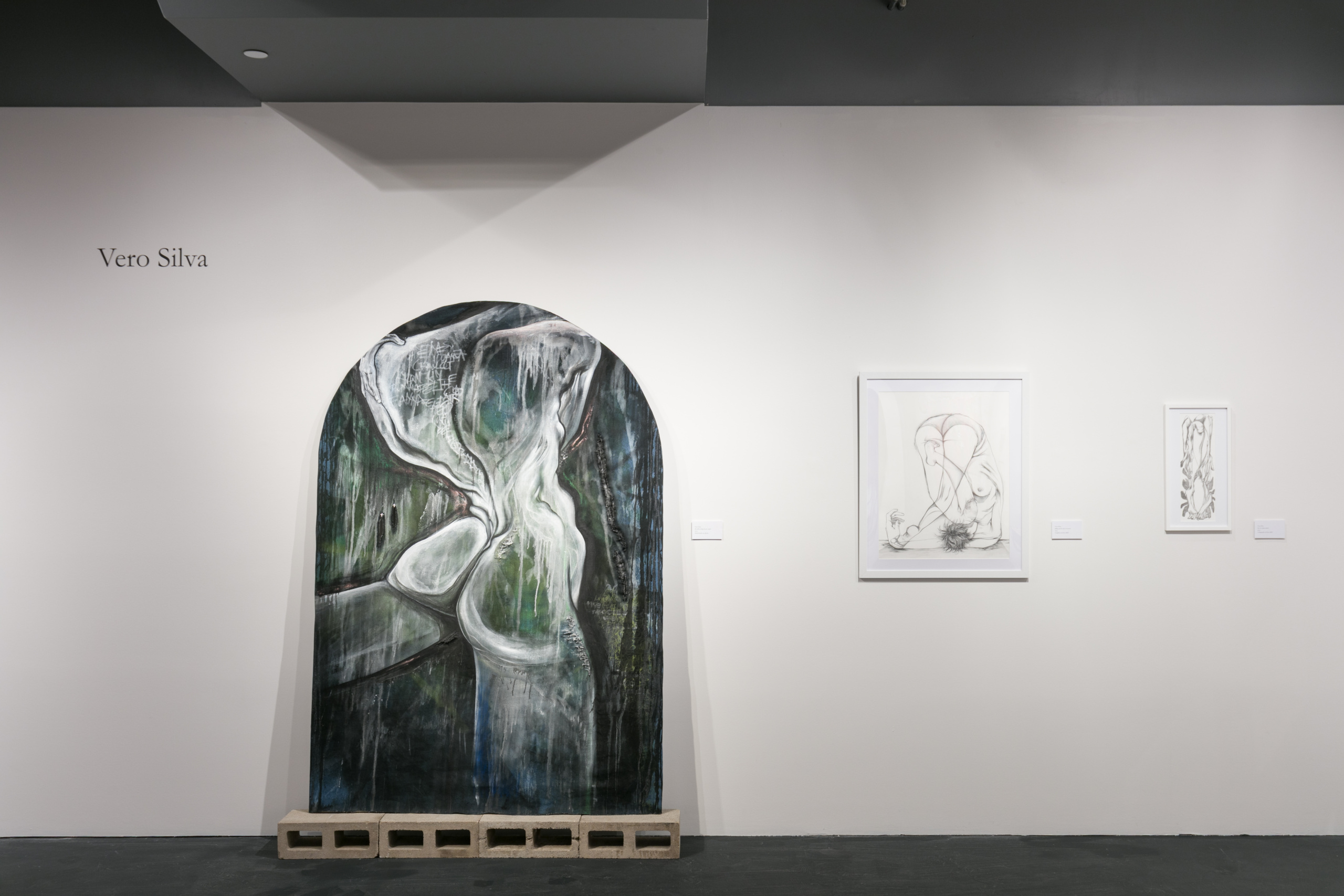
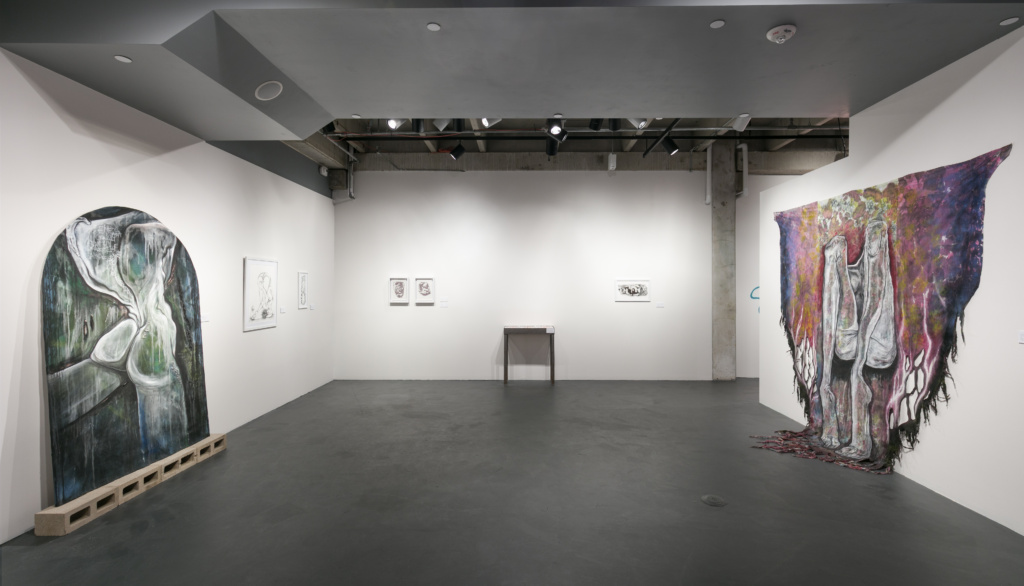
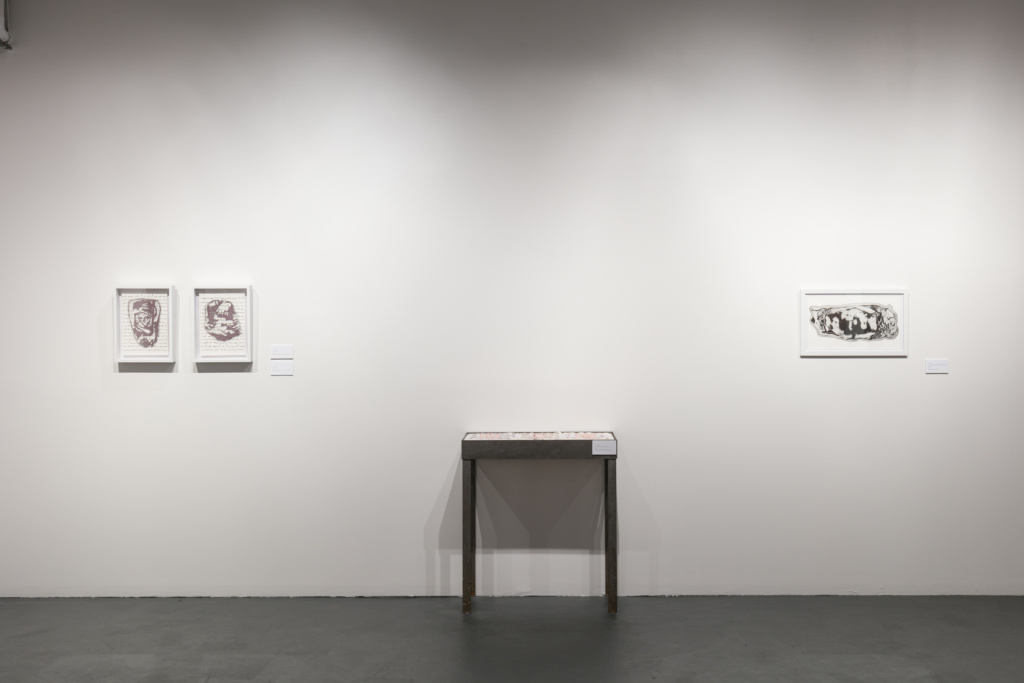
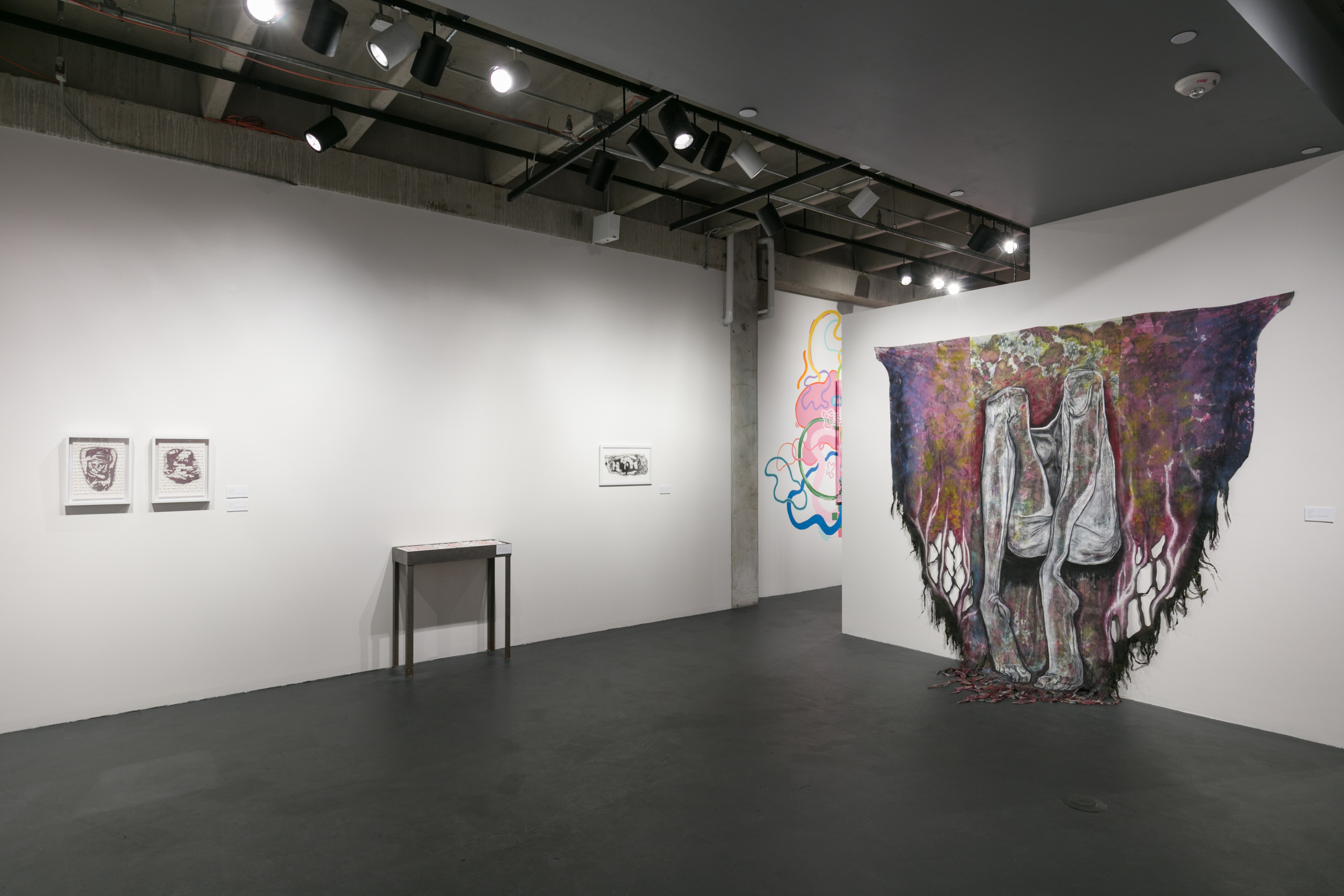

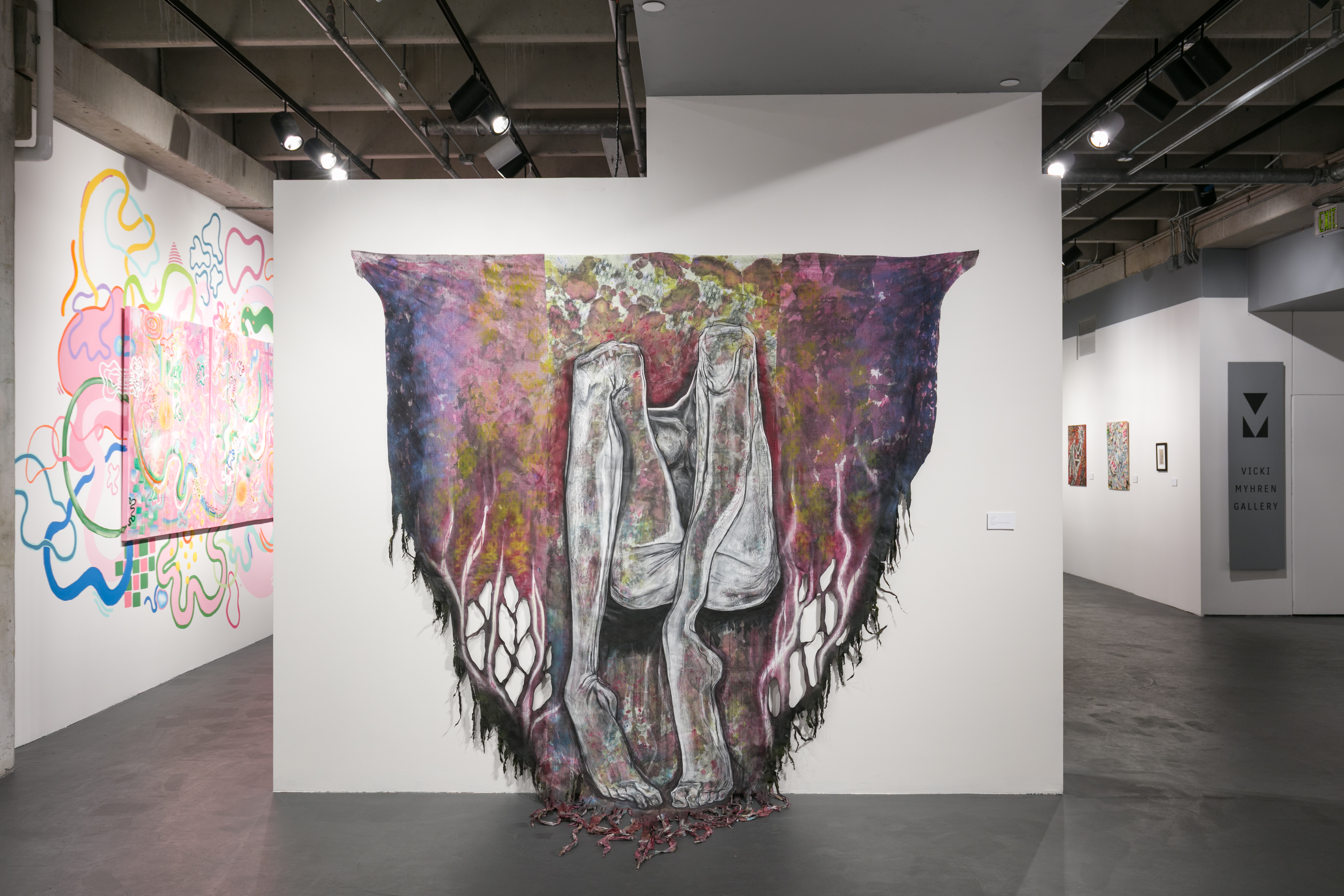
What does it mean to be seen? What does it mean to know yourself, your body, or your mind?
In this body of work, I seek to reclaim my volatile experience with ‘girlhood’ by illuminating parts of myself and psyche which may otherwise remain hidden. Through the exploration of fleeting thoughts, memories, and physical sensations, I work to transform my discomfort into tangible objects representative of my bodily experience.
Where my body ends and the earth begins is not a finite boundary.
The works displayed offer glimpses into the different dimensions of my being; together, the work exists as a series of non-traditional self-portraits. I push and blur the lines of beauty and unease through the contortion and overlapping of limbs, exaggerated folds and creases of skin, uncomfortable and vulnerable posing, and the combination of gestural strokes with immense detail. Though varied in t one, each piece honors the resilience of our bodies and presents them as extensions of the natural landscape we inhabit.
I find that our lived experience often mirrors the land around us; permeable and transient, undeniably enduring of hardships and pain, and overwhelming yet tranquil. I encourage viewers to reflect on their relationship with their bodies and consider how their perceptions may have been shaped by the natural world and the environment in which they were raised.
Phoebe Link
Bachelor of Fine Arts, Pre-Art Conservation
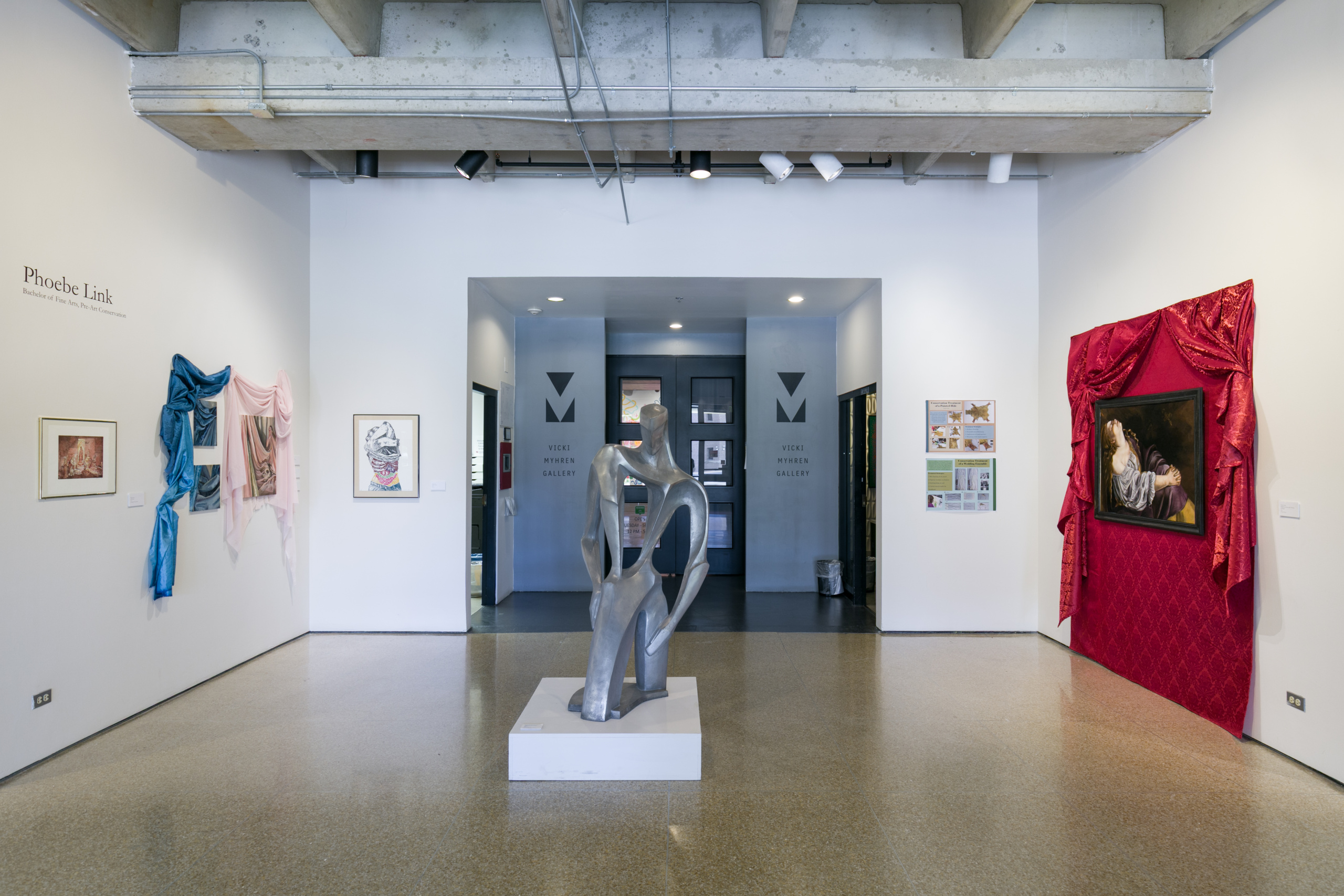
The BFA program in Pre-Art Conservation is among the more rigorous programs at DU. A highly demanding and specialized field, art conservation calls for an impressively broad skill base. Students master the practices of Art History, Studio Art, and Chemistry, combining these skills into the alchemy of art conservation. It is a rare and special student who is able to navigate this course of study. Students learn the principles, ethics, and practices of art conservation. The program culminates in an Internship and a hands-on conservation project in which the student conserves a particular work of art. This has ranged from paintings (in various media) to ceramics to stained-glass.
– Dr. Scott Montgomery, Advisor to the Pre-Art Conservation Program
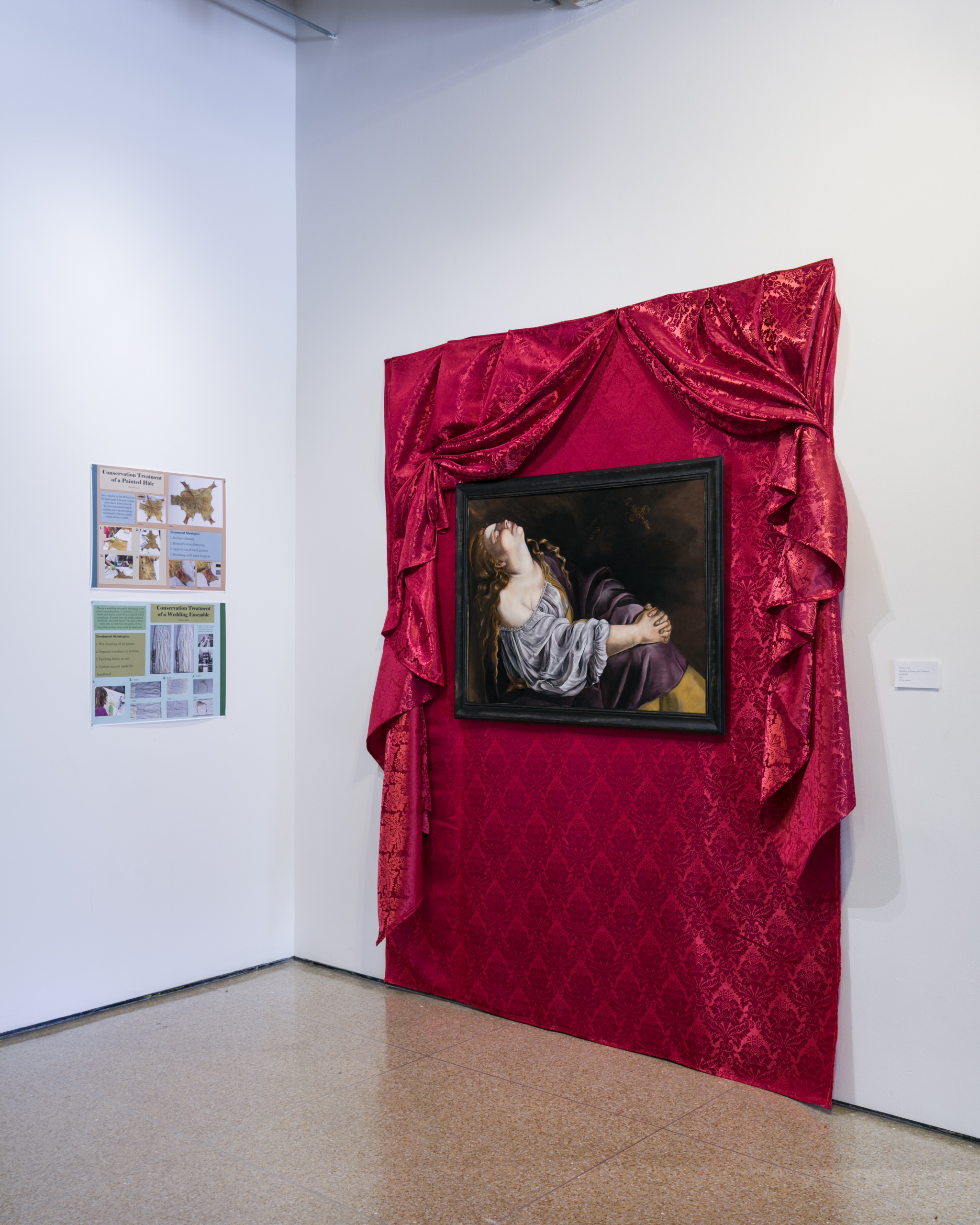
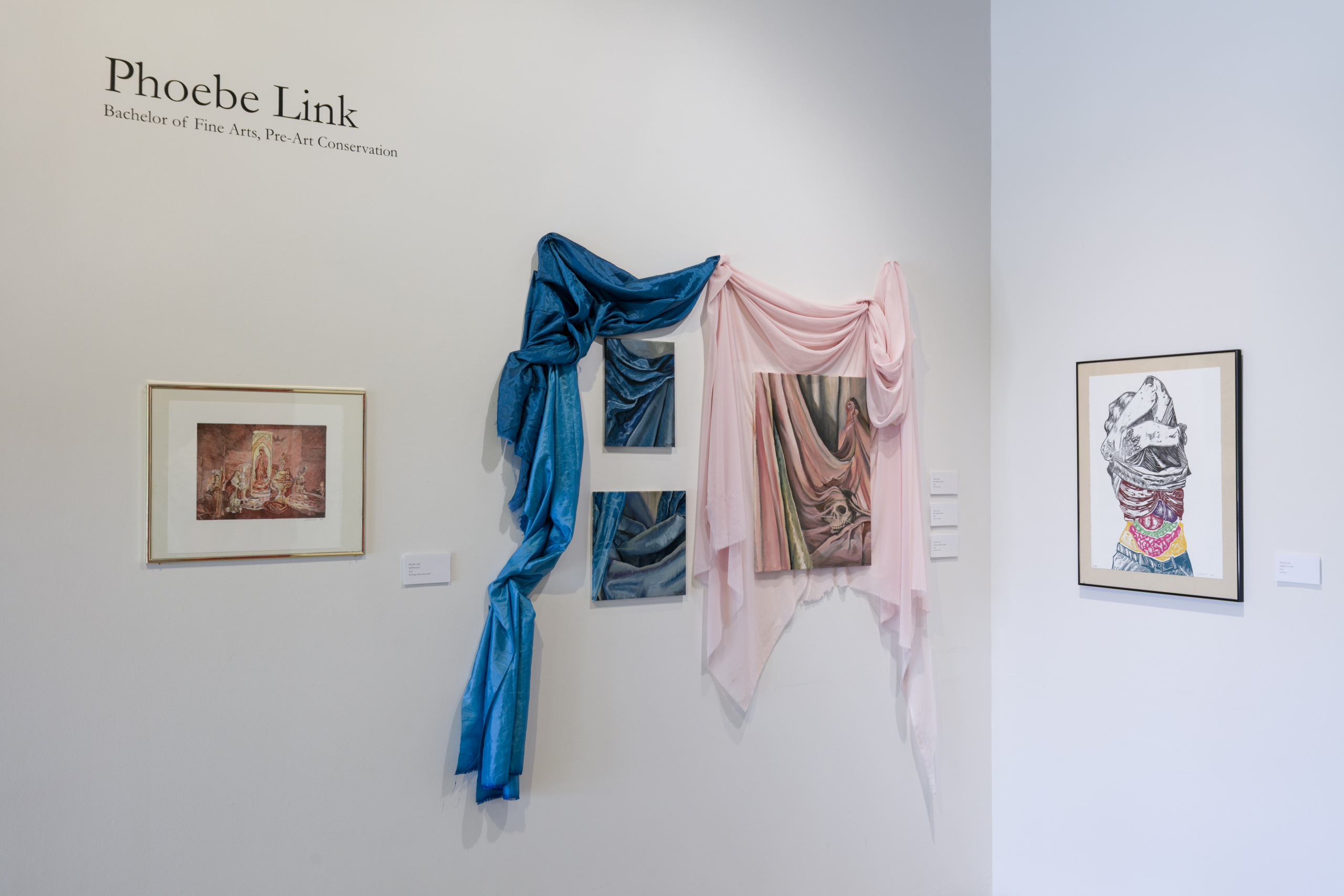
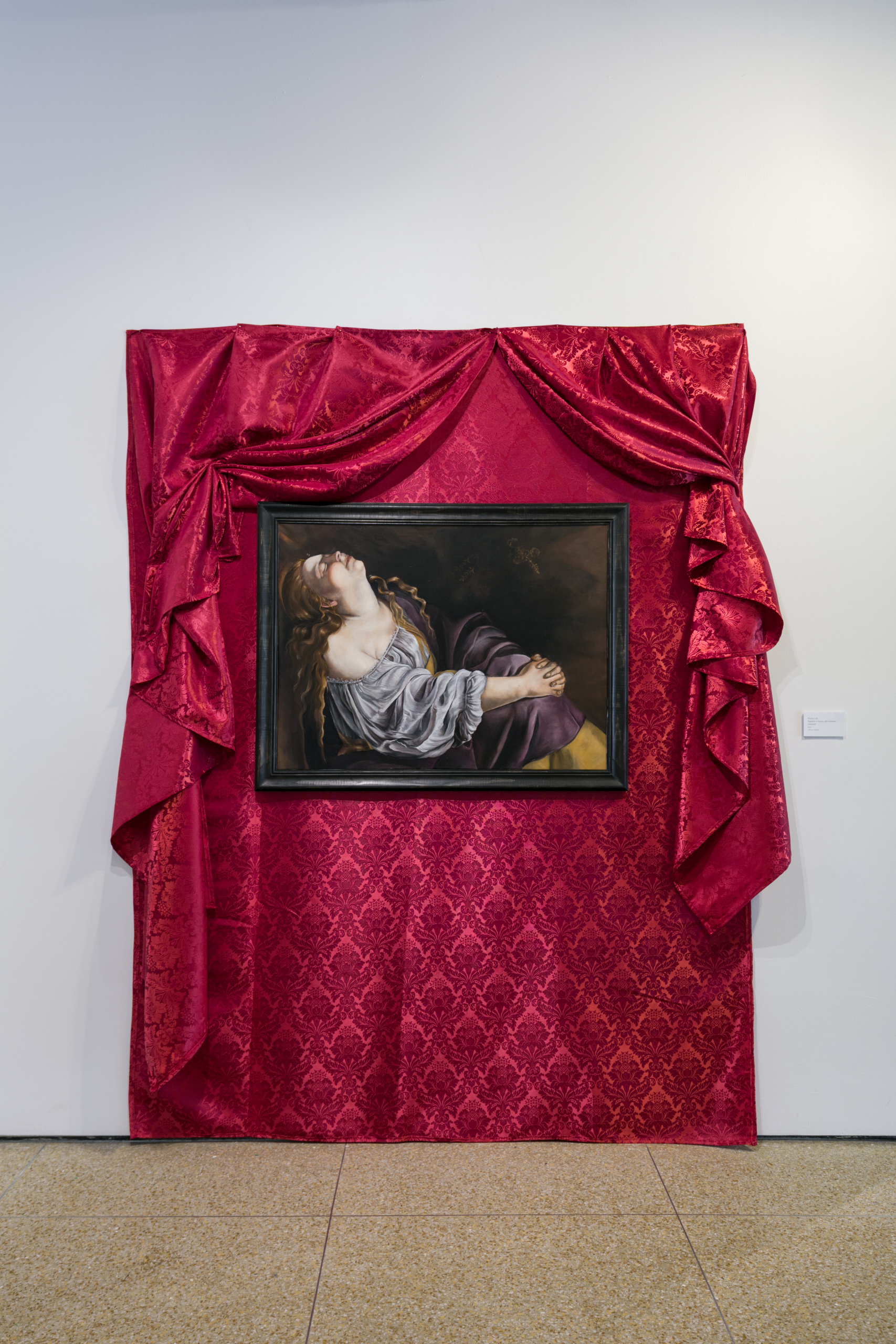
As a Pre-Art Conservation student, my primary interest is to preserve and protect art rather than create it myself. To do so requires a deep knowledge of and experience with studio art. The work presented here shows my exploration of studio skills throughout the past year.
Over the past year, I have had three main focuses which are represented in this show. The first is my conservation work. I had the privilege of being able to work on a painted Apache/Nde hide and a wedding ensemble from World War II. The posters detail my experiences working on these objects, as well as before and after images of treatment. These objects reflect my interest in textile conservation.
The next section of my work consists of technical studies in painting. In conservation, it is important to not only have very finely tuned hand skills, but also to be able to accurately recreate the hand of another artist. This section includes my studies of drapery, as well as a large master copy of Mary Magdalene in Ecstasy by Artemesia Gentileschi, 1620-1625.
The remainder of my work is an exploration of the idea of the human bodyas meat. My focus was on representing this idea visually, bringing the interior of the body to the outside where it can be seen. I used printmaking to represent this idea, as I find the process very physical and it makes me aware of my own body as I work with it. The body in art has been explored many times before, but my work grapples with the thought that the body isn’t conceptual or representative of the self, but merely flesh.
Bachelor of Arts Exhibition
Davis Gallery
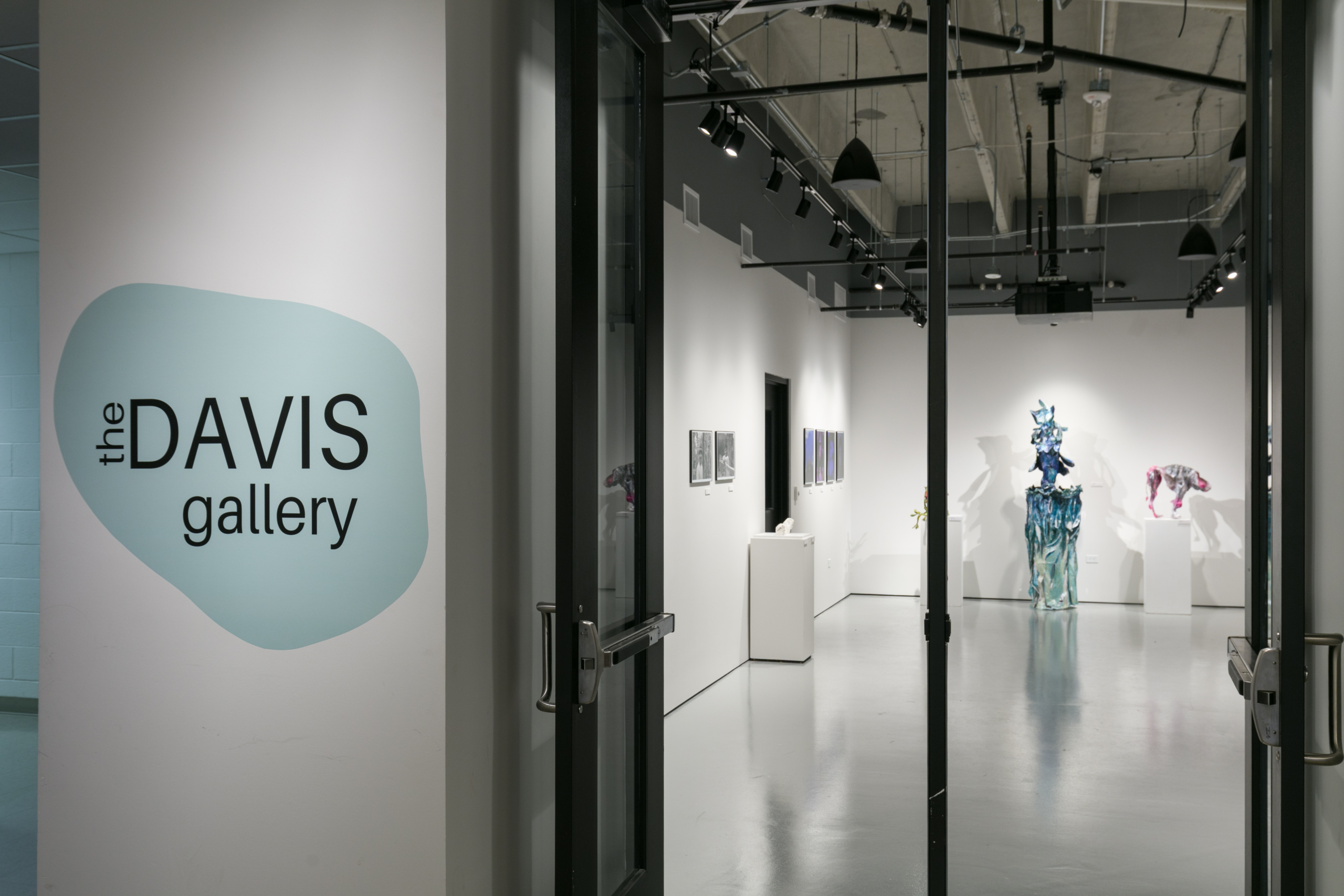
Featuring:
Jill Bogaty
Mary Garnsey
Jewell Nichols
Lisha Nouhan
Bailey Piskadlo
Mackenzie Saunders
Will Sieler
Morgan Sirota
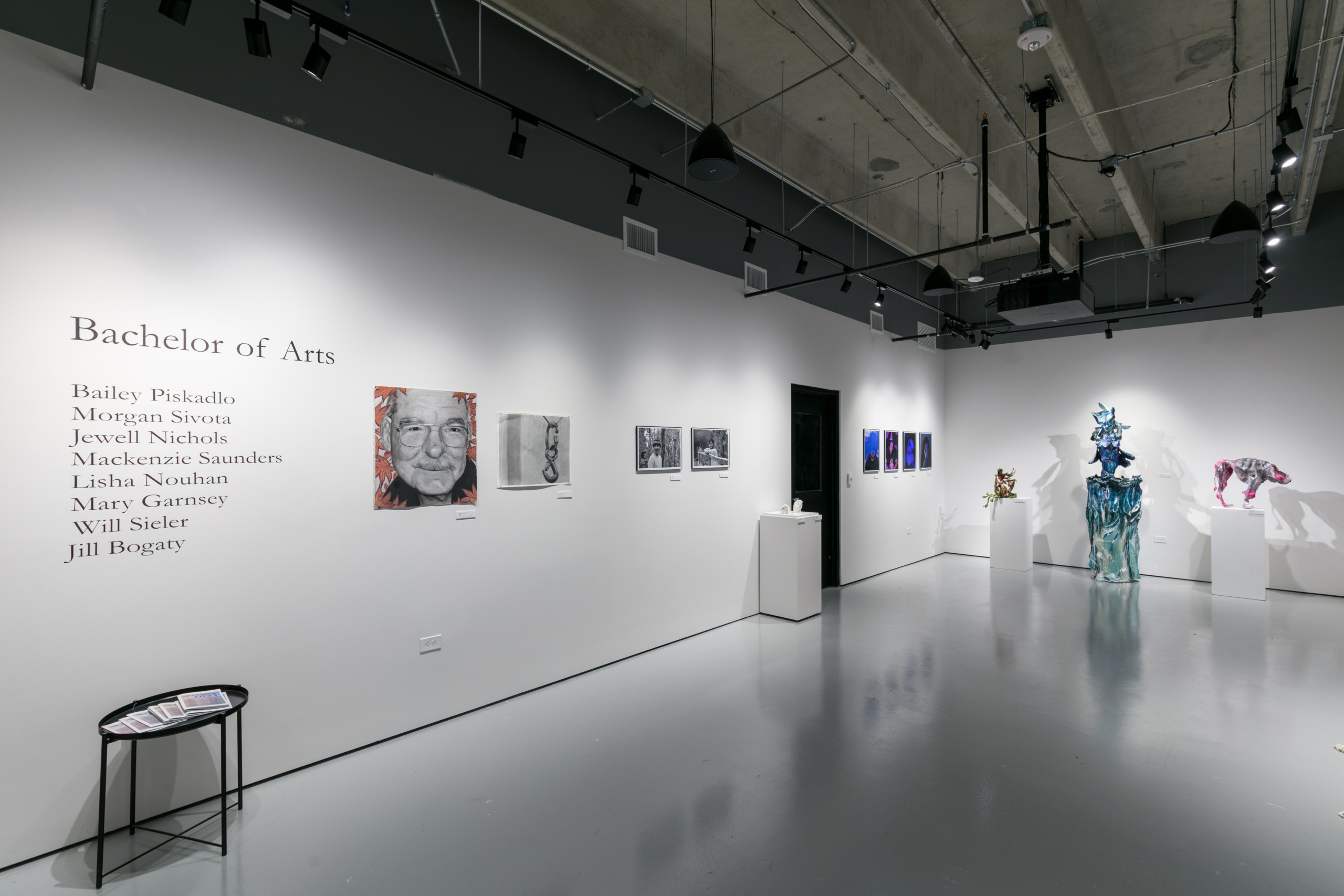
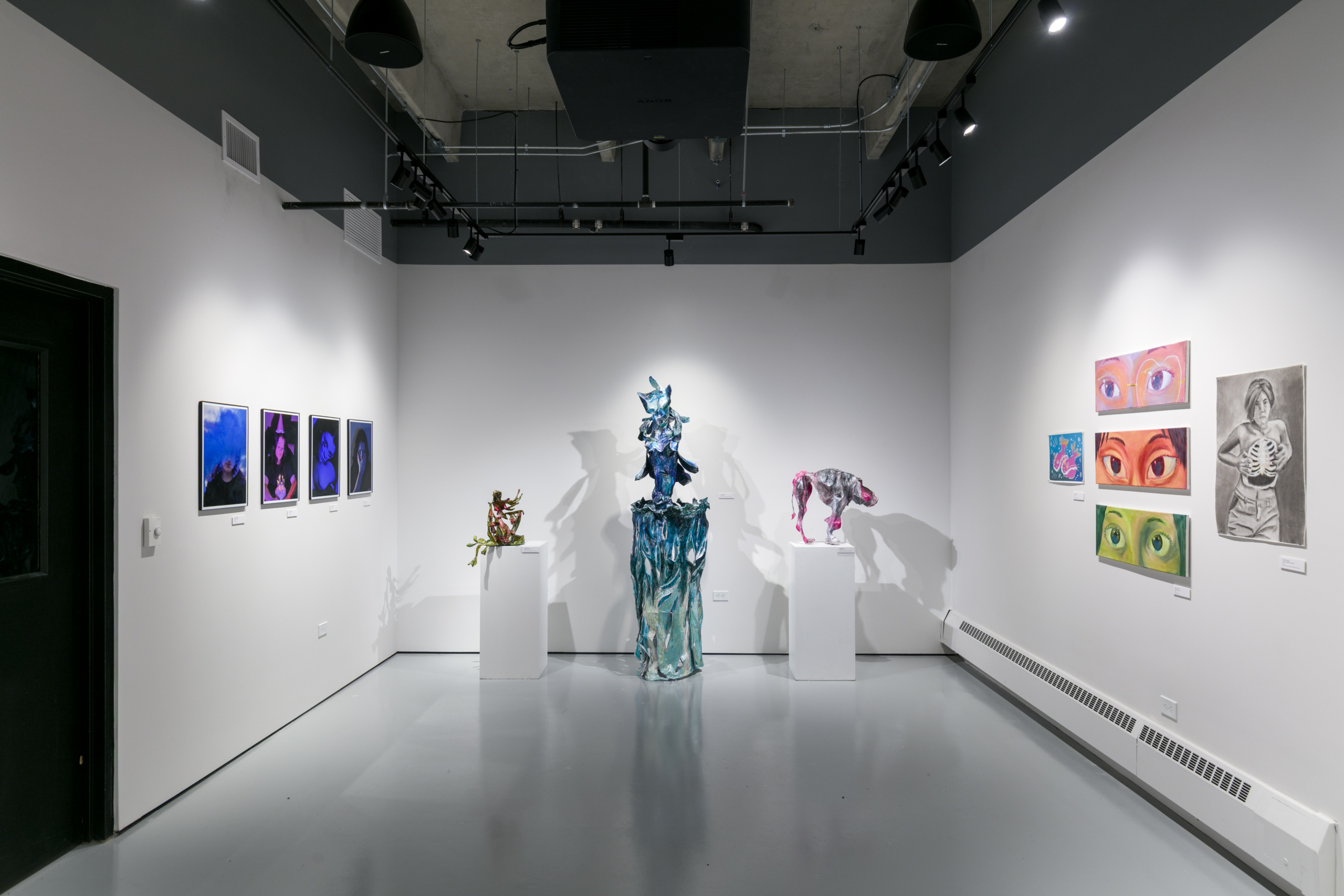
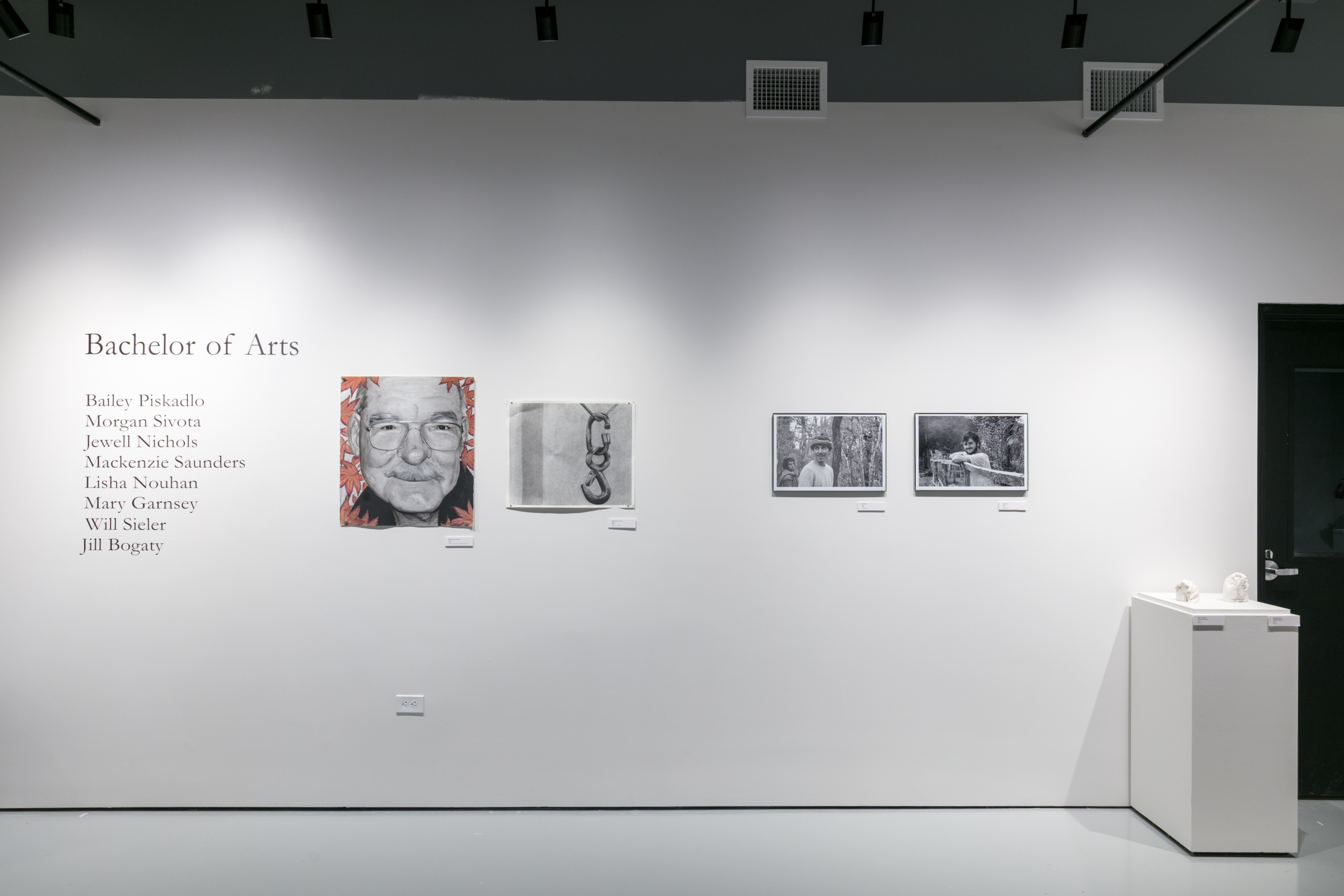
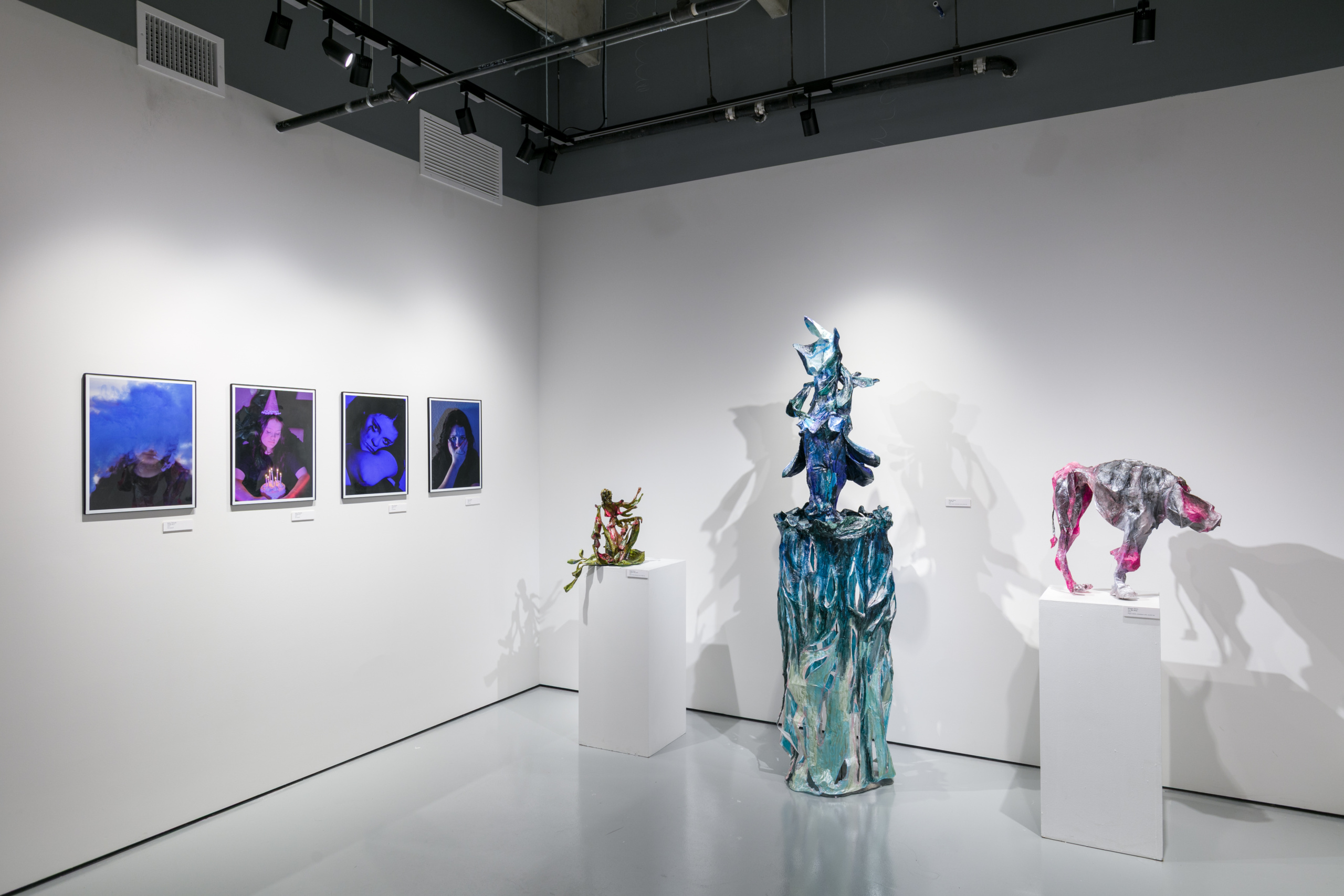
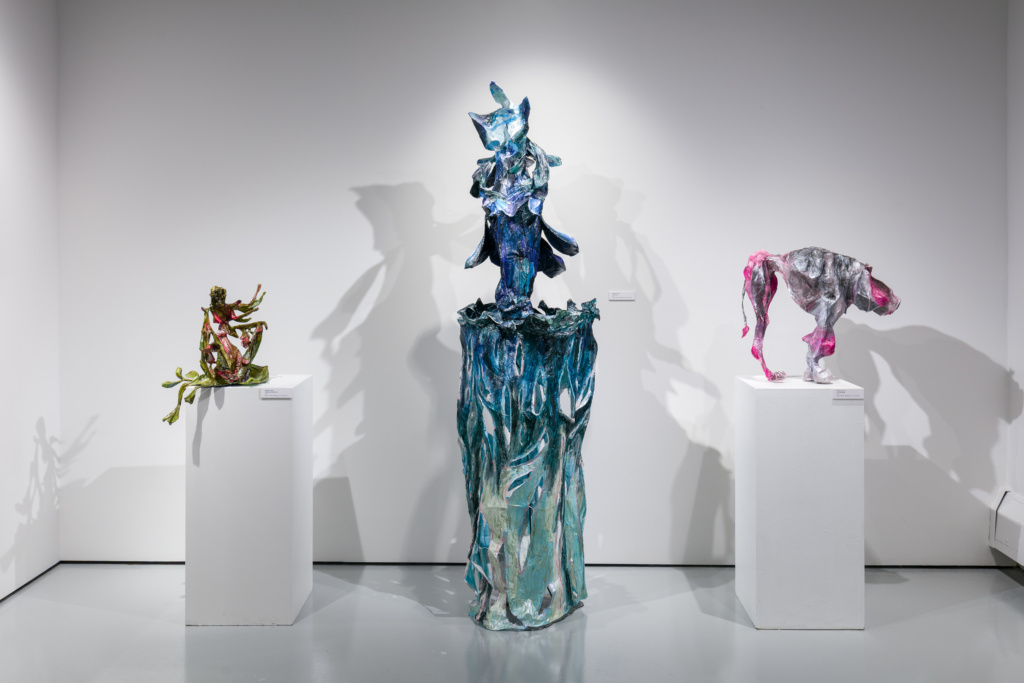
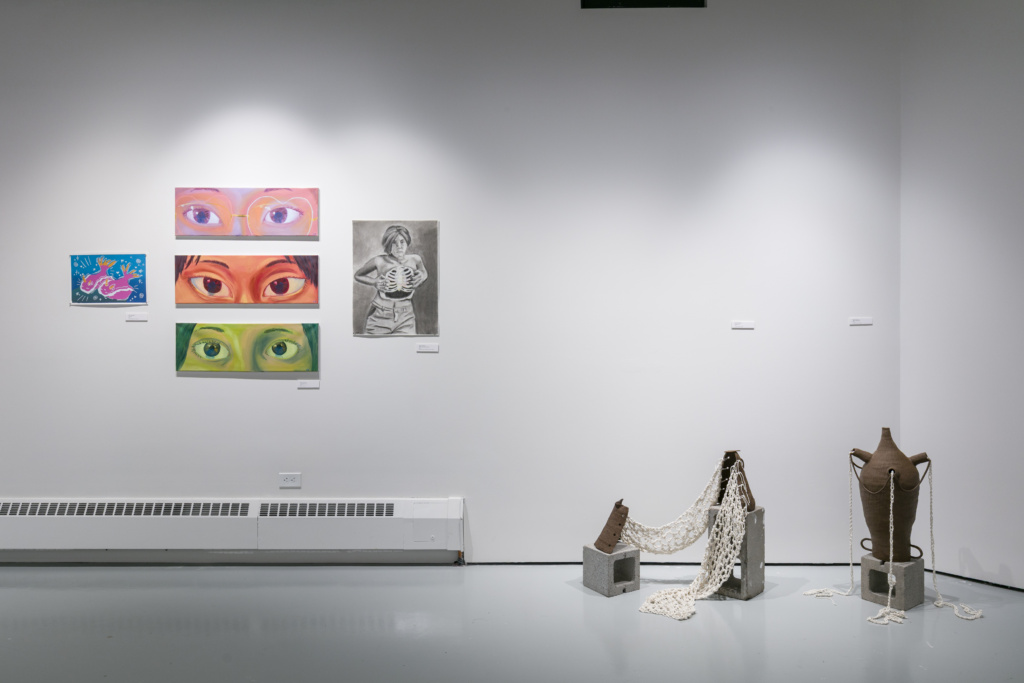
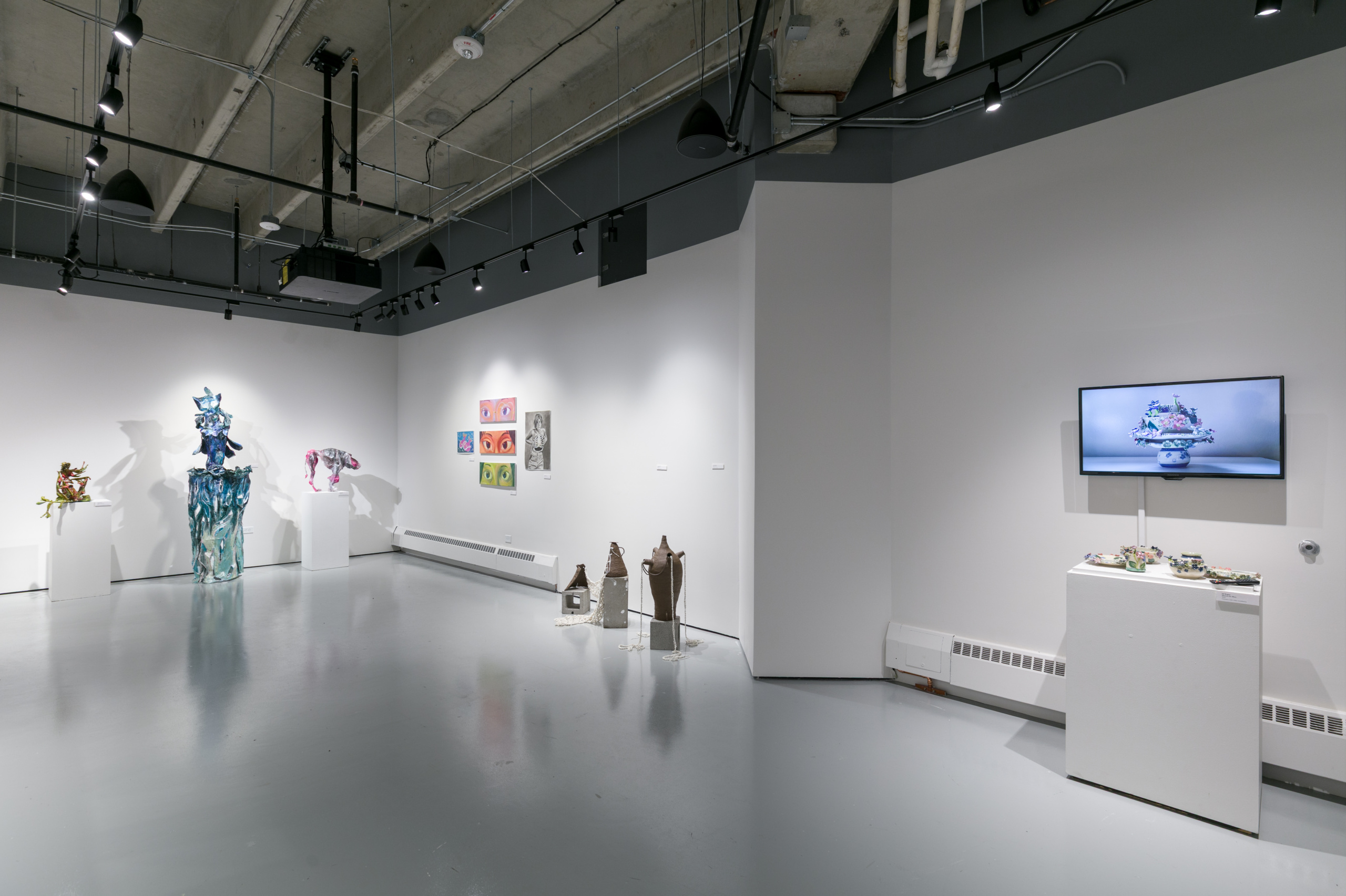
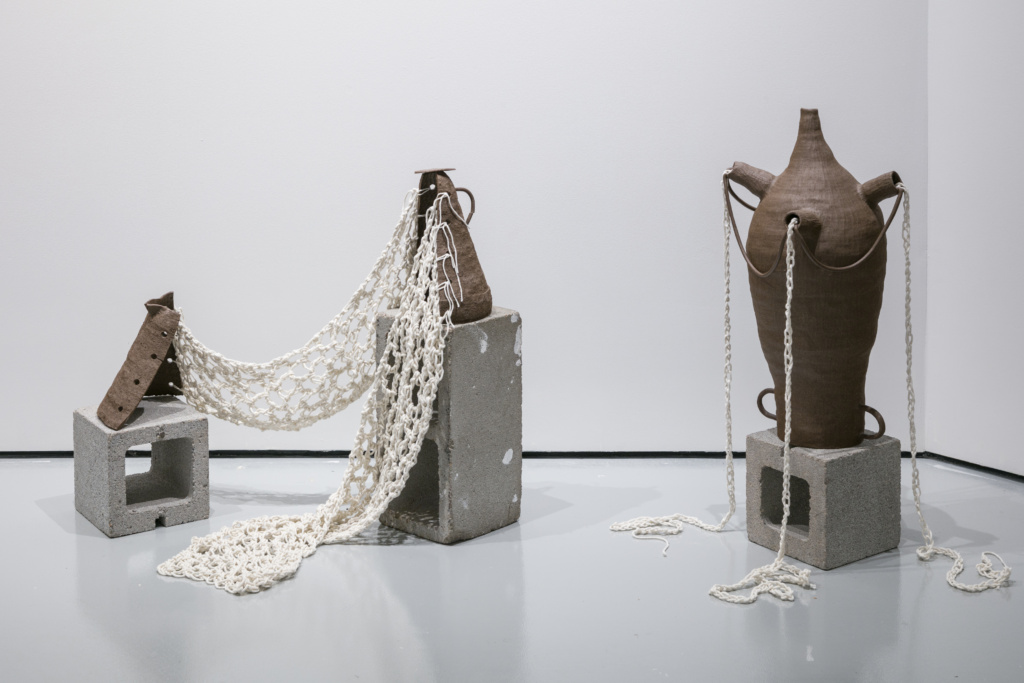
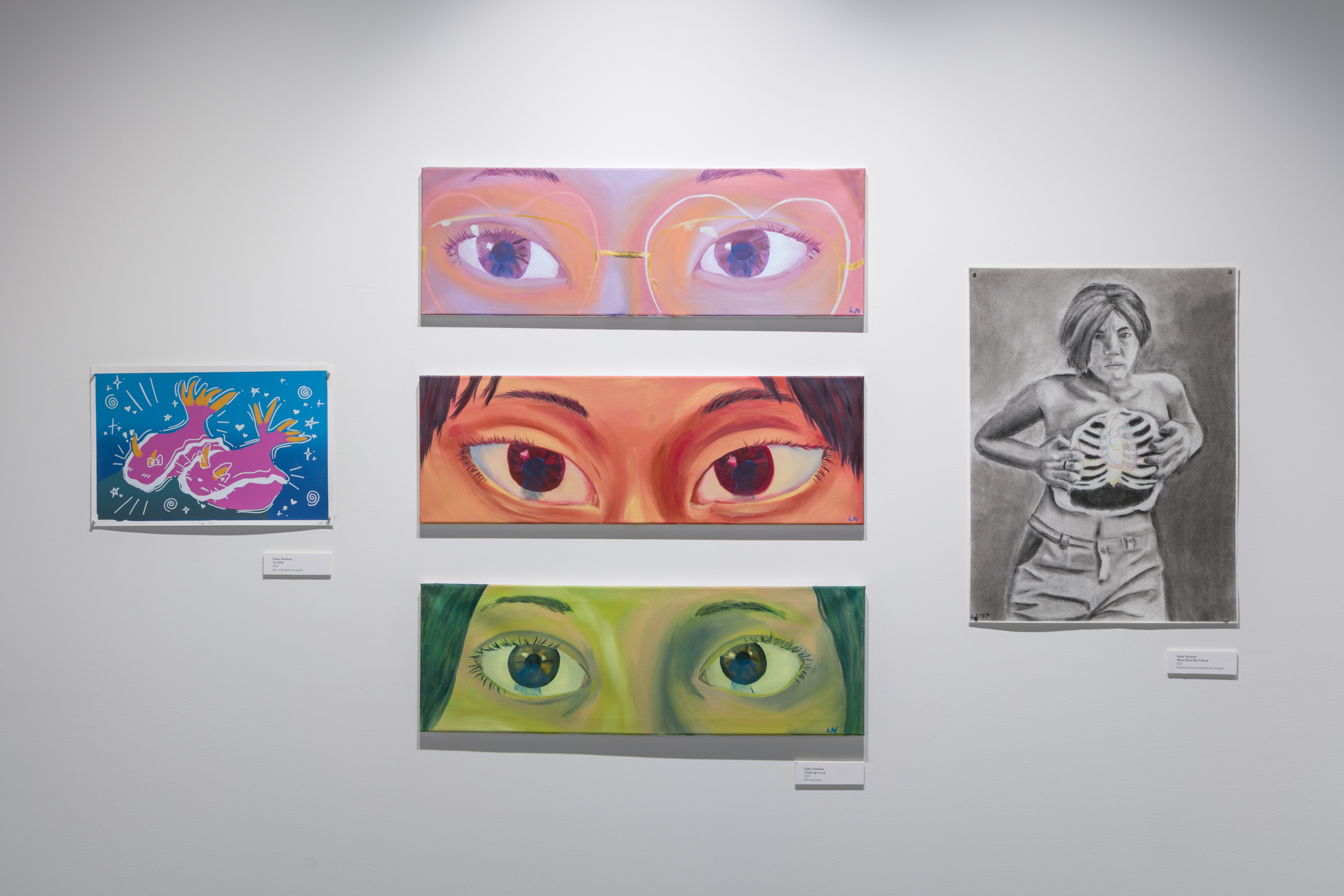
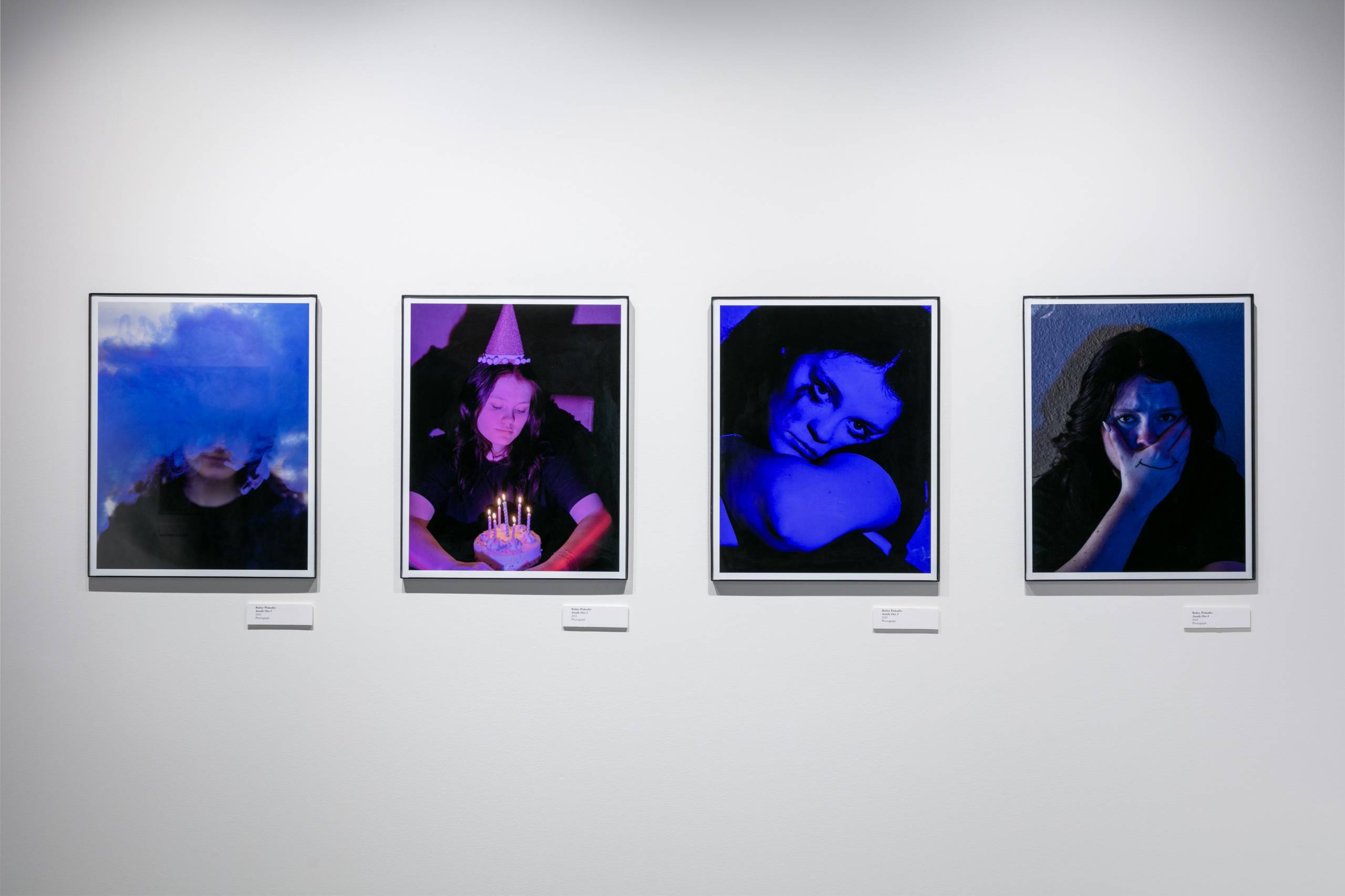
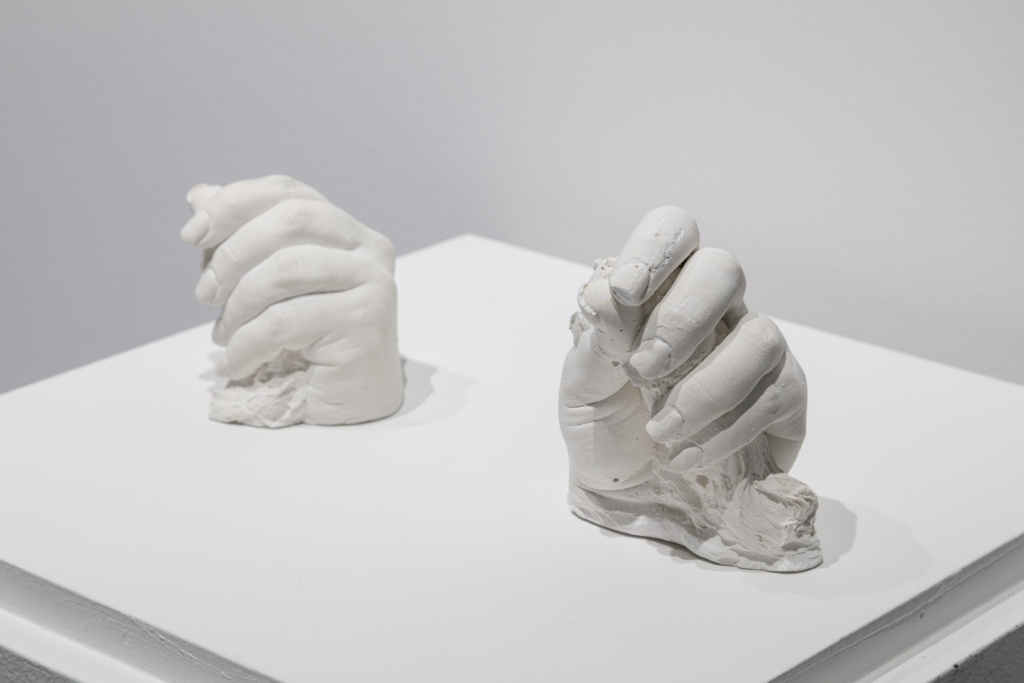

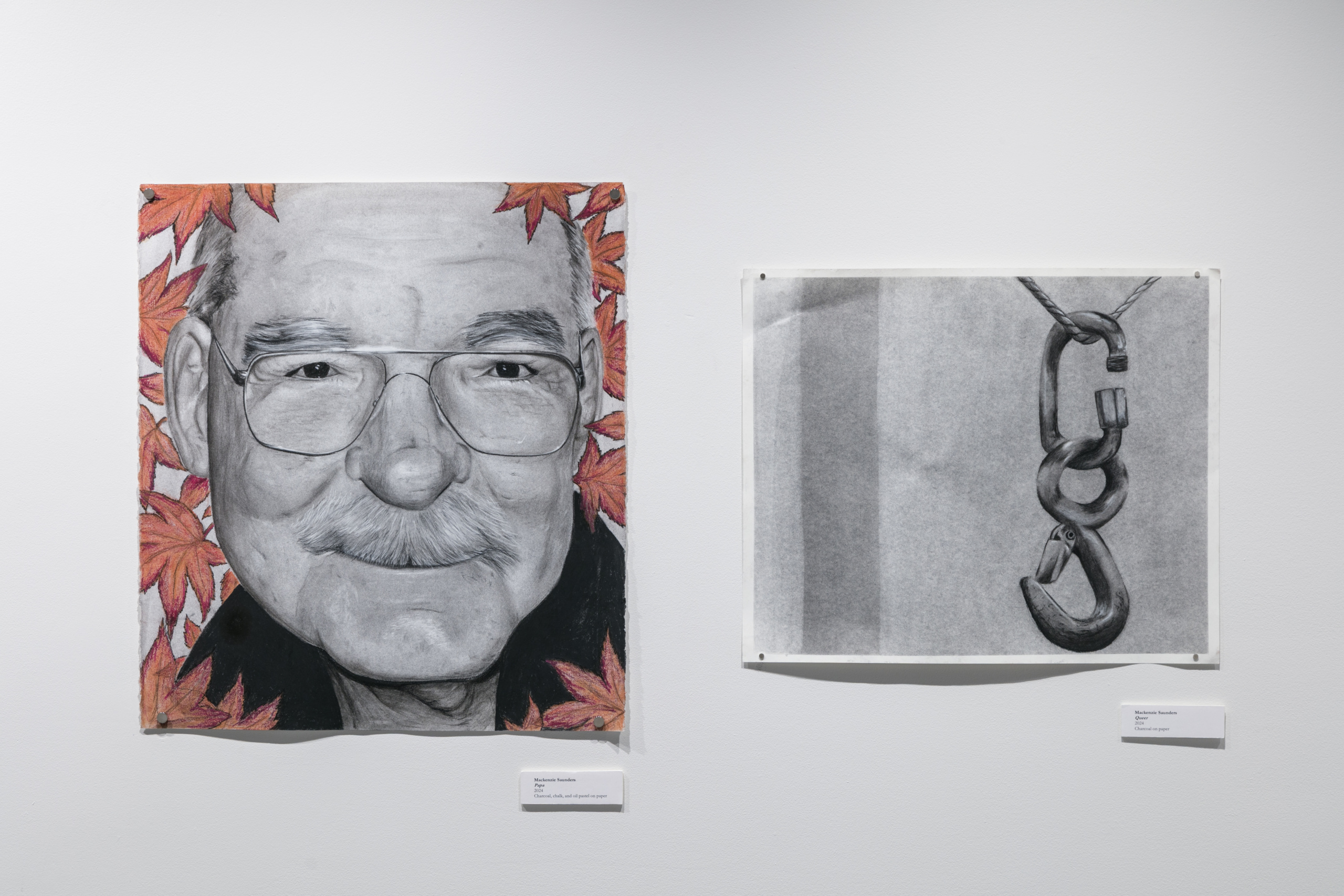
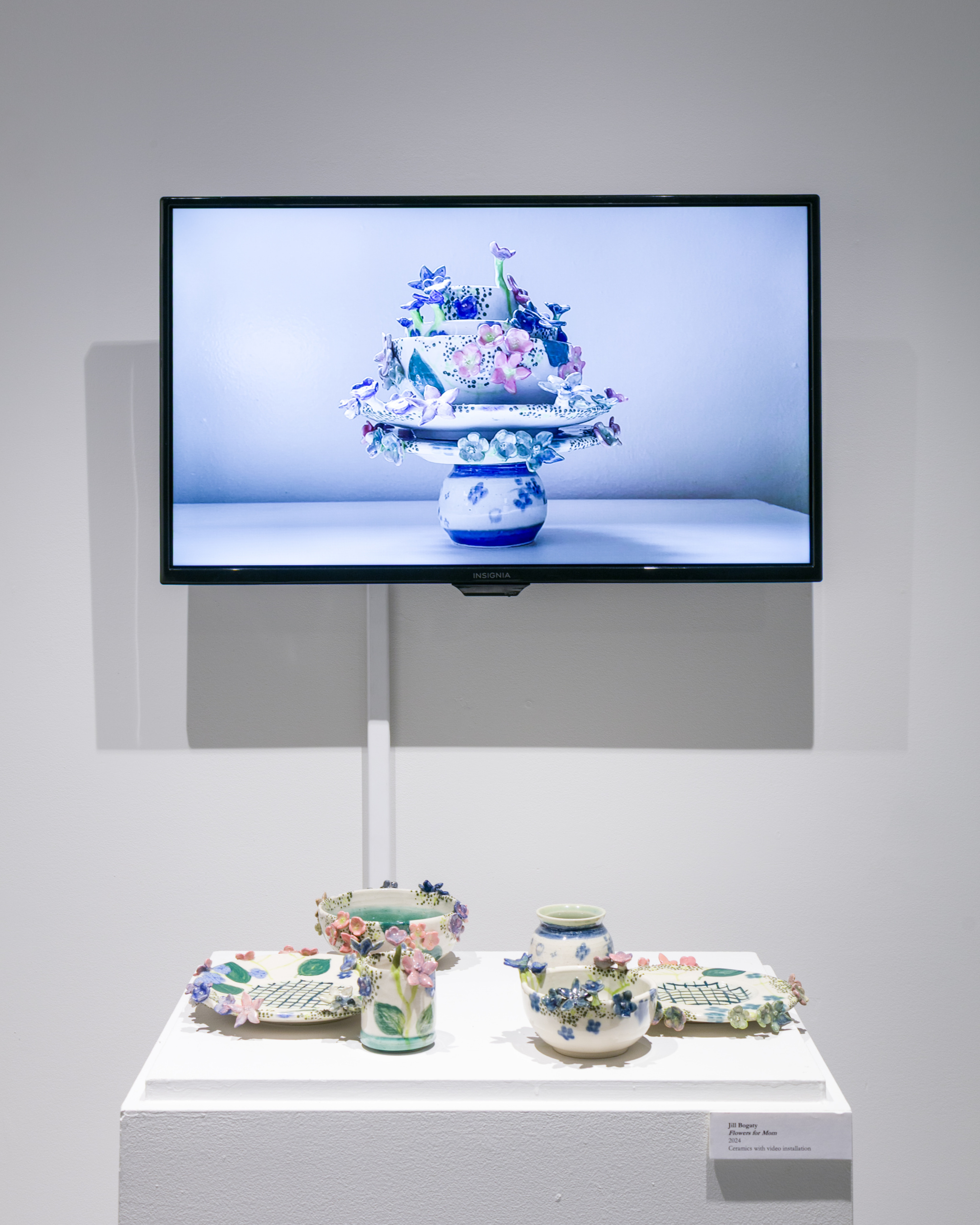
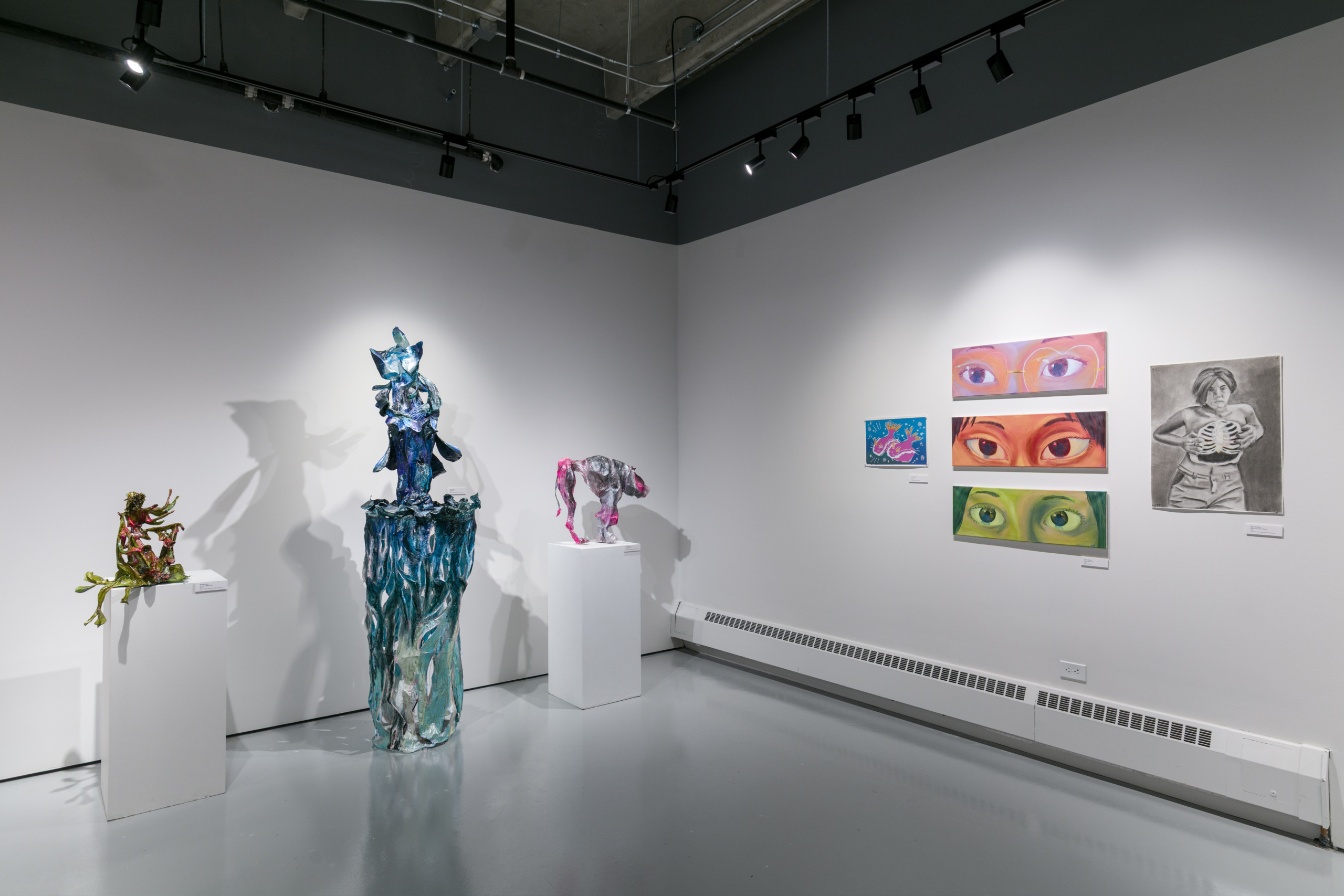
Photos by Wes Magyar
